Archived Storm Damage Blog Posts
How to Prepare for Winter Storms & Frozen Pipes
1/28/2022 (Permalink)
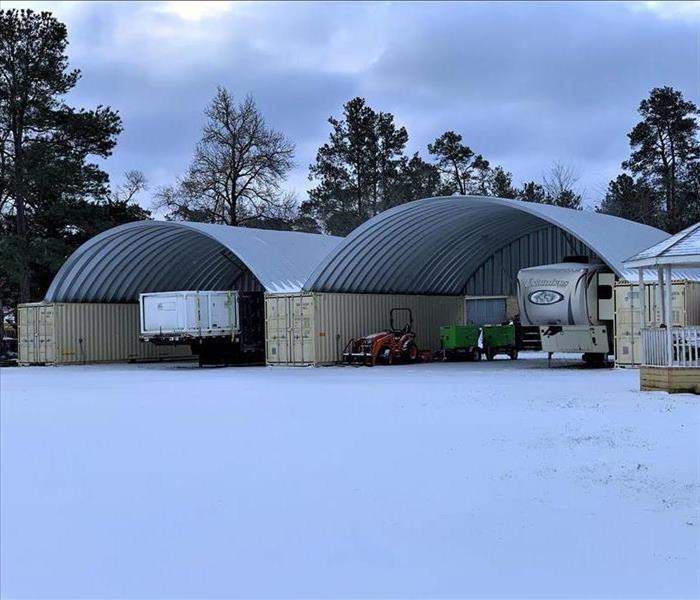 SERVPRO of Indianapolis West
SERVPRO of Indianapolis West
The winter season is here and snow and ice can create major issues for you and your home. As we prepare to support you, it’s best for every business and homeowner to review potentially problematic issues.
Whether it’s snow, ice, heating, thawing frozen pipes or unforeseen accidents, the combination of certain elements can destroy your property. Most people will know to be aware of frozen pipes in the house, but other issues may arise. Ice on your roof can prevent proper drainage, if heat isn’t evenly distributed, some areas may freeze, and water in frozen pipes will freeze causing secondary damage to other appliances or household systems.
Here are three preemptive ways to check in on your property.
- Insulate Your Roof
The best ice dam prevention solution is to properly insulate your roof. Heat escapes through ceilings and rises to the roof where it warms the wood and shingles above. To prevent this, check the depth of your insulation.
Anything less than 8 inches is usually not enough to prevent heat from escaping, and it's important to use foam or caulk to stop air leaks. This will not only stop roof issues, but it will also save you money on your energy bill.
- Remove the Buildup
If you notice a large amount of snow gathering on your roof, you might want to consider eliminating it. Houses that have poor ventilation can also have poor distribution of heat. By removing the snow with a push broom or shovel, you can clear any potential problem areas.
- Create Channels in the Ice
Ice dams can force water into your home through the attic. You can stop this by creating channels in the ice and draining the water into the gutters. Use a hose with warm water and melt the lower edge of the ridge. This solution is a temporary fix but could prevent a large amount of winter storm damage.
Winter storms will always be unpredictable and damaging in one way or another. Our only working defense is to focus on potentially preventable tactics.
You do not need to figure out how to prevent pipes from freezing or fix frozen pipes on your own. Feel free to reach out to us at SERVPRO of Indianapolis West for additional information on how to protect your home, we're always here to help!
Every state in the US is vulnerable to flooding.
6/29/2021 (Permalink)
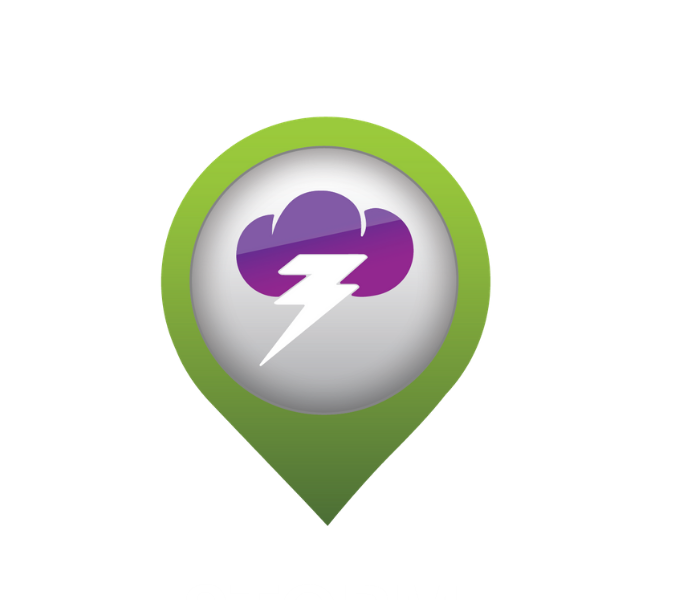 SERVPRO of Indianapolis West is here to help.
SERVPRO of Indianapolis West is here to help.
Indianapolis homeowners may be surprised to know that every state in the US is vulnerable to flooding--even the dry ones. Storm damage repair in Indianapolis will always be a valuable resource. Changes in sea level, as well as weather patterns, are enough to create sudden floods that cause damage to homes and infrastructure.
Homeowners with flood coverage will still need complete restoration from our professional cleanup team if a flood was to occur. Being prepared and asking your insurance agent about flood coverage is the first step. Once you're aware of what's needed and what a flood policy would cover for your home, you will know exactly what to do if an event like this was to occur.
Water can make it's way through any structure causing long-term damage. It is important to hire professionals to provide a thorough water damage restoration process to prevent secondary damage. You can potentially need mold remediation in the future if microbial issues are detected.
If your home has been affected, you need a water restoration company in Indianapolis that can provide storm damage restoration and rapid flood damage cleanup.
SERVPRO of Indianapolis West technicians are ready to restore your home or business to a preloss condition. Our team has received training from the IICRC to provide the highest standards of cleaning for fire, water, and mold damage.
We work with insurance companies and homeowners to ensure all cleanup processes comply with policy in the event an insurance claim does need to be made.
Completing a Proof of Loss for Your Flood Claim
Your insurance adjuster can assist you in the process of filling out the right paperwork and completing this portion of your claim. Make sure you file as soon as possible and everything complies with the needs of the Standard Flood Insurance Policy. This will help ensure you are paid within 60 days of the flood.
SERVPRO of Indianapolis West technicians will take photos of the damage, document inventory of all possessions, and coordinate with both you and your insurance adjuster. If there are important documents that need to be restored, we can scan and create electronic copies so you can have access to them promptly.
A successful cleanup begins with thorough monitoring of the situation. SERVPRO of Indianapolis West use a variety of moisture meters to evaluate the extent of damage before extracting , disinfecting surfaces, and drying your home.
Throughout the drying process, we can use penetrating and non-penetrating moisture sensors and meters to determine the progress from our restoration services. Infrared imaging allows technicians to see behind structures to determine if subfloors, studs, or fiberglass insulation require further drying.
Every surface in your home has an ideal humidity level to maintain its integrity, from hardwood flooring to drywall or your furniture. SERVPRO of Indianapolis West strives to ensure your items that can be safely restored are handled with the utmost care.
Possessions that require replacement are not removed without documentation and the informed consent of homeowners and insurance adjusters.
Your home could potentially need general contracting services for restoration services, which we can walk you through once you decide. SERVPRO of Indianapolis West is licensed to handle both restoration and rebuilding this type of work.
Check out The Weather Channel as they discuss why storms are so hard to forecast.
SERVPRO of Indianapolis West provides a mitigation service that is Faster to Any Size Disaster.
What can you do before a Storm arrives?
6/7/2021 (Permalink)
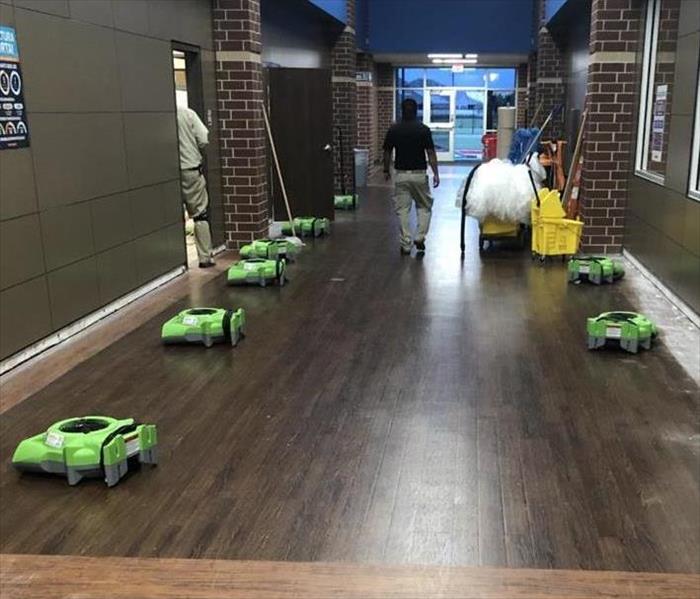 24/7 Emergency Cleanup & Restoration
24/7 Emergency Cleanup & Restoration
Floods can be surprising, and they can catch you off guard. Water is incredibly damaging, and most people would be surprised at what water can do once it sneaks its way into your home. SERVPRO of Indianapolis West is here for you for suggestions and life saving tips.
Our crews are highly trained and licensed to work in these situations. It is important to us to get out there and protect your property as quickly and professionally as possible, as we ensure the water will not migrate and cause additional damage to the surrounding areas.
Flooding can be dangerous and scary. Be sure to have emergency kits with you at all times in case of a storm.
If for any reason, you and your family are unable to make it out of your home or town when a storm is coming, there are ways to be Storm Ready.
Follow the steps below to feel better prepared when a storm hits:
1.) Have a home emergency plan. Know all your safe exit points of the home, what to do with pets, keep on hand at least 2 Emergency Kits, and let your neighbors know you are still at the home.
2.) Stock up on the easy essential foods, water, toiletries, candles, lighters, and flashlights. Have plenty of blankets and pillows handy.
3.) Keep some games and toys for the children handy--Waiting for the storm to pass over might get boring in some cases.
4.) Secure loose things around and on your property.
5.) Make sure there are no branches hanging over your home or garage.
6.) Stay indoors when the storm is upon you.
7.) Ensure your home, contents and car insurance is adequate and current.
8.) Learn how to safely turn off your power, water, and gas.
9.) Keep a battery powered radio nearby so you can keep up with warnings and updates on the storm.
10.) Keep water containers, a camping stove and fuel safely on-hand.
Stay safe and prepared for storms in your area.
Call us at SERVPRO of Indianapolis West for more information on preparedness.
Storm Damage to Your Indianapolis Home or Business
3/10/2021 (Permalink)
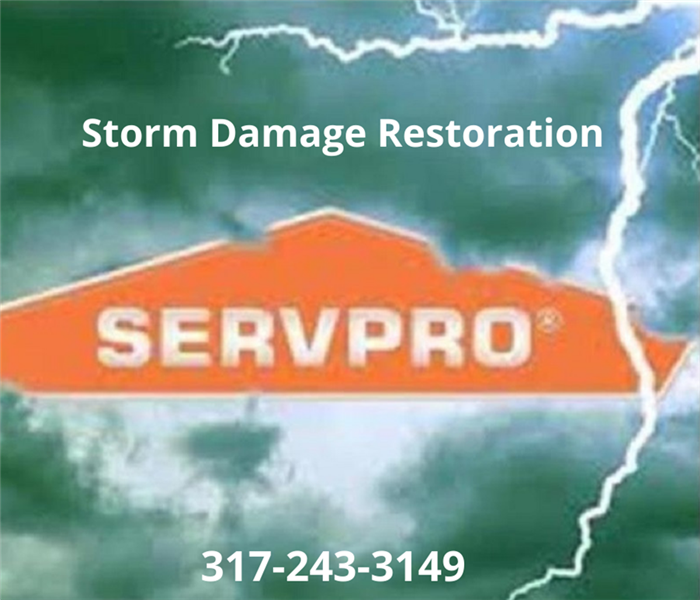 When storm damage hits your home or business, call SERVPRO of Indianapolis West and we'll make it "Like it never even happened."
When storm damage hits your home or business, call SERVPRO of Indianapolis West and we'll make it "Like it never even happened."
While it's still technically winter here in Central Indiana, springtime is right around the corner, and we all know what that means. Storm season is approaching, and SERVPRO of Indianapolis West is ready to help. Indianapolis will once again receive heavy rains, wind, and tornadoes to deal with this springtime. These storms are notorious for causing heavy damage to homes and businesses throughout Central Indiana.
In this blog, I will outline several ways SERVPRO can assist after a storm damages your property. Here are just a few of the services SERVPRO can offer to help reduce stress in your time of need.
- Emergency Board-up
- Water Restoration
- Caring for your Belongings
- Mold Remediation
- Stress-Free Claims Process
Emergency Board-up
A board-up to the structure is a critical first step in the restoration process. A fallen tree or broken limbs may have damaged your roof, or high winds removed shingles causing water to enter. If a tree limb or other heavy debris fell on your roof during a storm, your home might have structural damage, so be cautious.
We use strong plywood or tarps to cover any broken windows or holes in your roof. This is done to preserve the structure and keep your home or business and its contents safe from further exposure to the outside environment.
Water Restoration
We will remove excess water, set air movers and dehumidifiers in place to dry your home or business. We may use powerful submersible pumps in addition to industrial strength, wet/dry vacuums. It usually takes two to four days to dry a structure after water damage has occurred.
Our technicians carefully monitor the progress daily, using moisture meters and checking that the materials such as carpet and drywall return to acceptable drying levels. This ensures the structure is drying correctly and lets us know when to remove the drying equipment.
Caring for Your Belongings
If you have to relocate due to severe storm damage, be sure to gather sensitive documents and items such as birth certificates, social security cards, insurance papers, financial records, valuable jewelry, gold, and coins.
SERVPRO of Indianapolis West can conduct an organized, efficient move-out of your contents. Move-outs will provide benefits, such as protecting items from secondary damage and offer a quicker remolding process.
When restoration is completed, we will work with you to coordinate the move-in according to your needs.
Mold Remediation
When a home or business suffers a water damage event from a storm, a mold infestation can quickly arise and spread throughout a structure in as little as 48-72 hours. Mold must be taken very seriously; it poses health effects, especially to those with asthma and low immune systems.
It's critical to call SERVPRO of Indianapolis West as soon as suspect water damage. Our highly trained technicians may need to use containment procedures and physical barriers along with negative air pressure to keep the mold spores from spreading during the cleanup process.
Stress-Free Claims Process
SERVPRO of Indianapolis West is a preferred service provider with most insurance companies in Central Indiana. Our knowledge and experience working with insurance companies allow us to quickly and easily manage the claims process and paperwork. We can work directly with your insurance provider throughout the entire process.
Call the Storm Damage Restoration Professionals
When storm damage strikes, a fast response is critical. Day or night, Indianapolis residents and business owners can expect us to respond immediately to your emergency. Our office is strategically located in Indianapolis, and that gives us the ability to act fast and arrive "Faster to Any Size Disaster."
Call us, SERVPRO of Indianapolis West. We always have a live SERVPRO representative to help answer your questions and dispatch a crew 24/7 for emergency services. Click here or call 317-243-3149
Freezing Temperatures Cause Pipe Breaks In Indianapolis
1/8/2021 (Permalink)
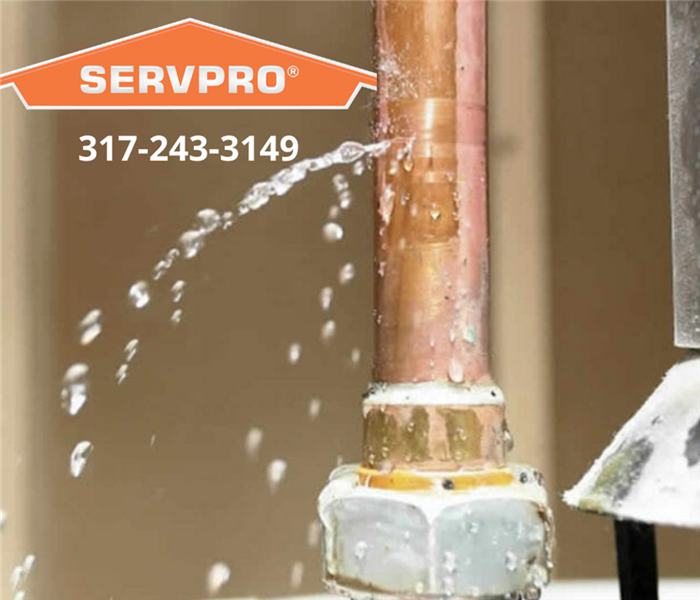 Call SERVPRO of Indianapolis West and we'll make your water damage "Like it never even happened."
Call SERVPRO of Indianapolis West and we'll make your water damage "Like it never even happened."
With winter in full swing here in Central Indiana, freezing temperatures are on the way. Every winter, we service many homes and businesses with busted water pipes due to extreme temperatures. It's very common here in Indianapolis to have a water supply line freeze and cause severe water damage.
Slow Drip
One of the best ways to help prevent frozen pipes during frigid nights is to let the faucets slowly drip. Running water through the pipes will help prevent them from freezing. Also, open cabinet doors under the sinks to allow the home's heat to circulate underneath. Allowing the home's air to circulate will add a few degrees and make a tremendous difference.
Above 55 Degrees
Kitchen sink water pipes are one of the most common lines to freeze because kitchen sinks are usually facing an exterior wall. Keeping your garage door closed and your house temperature above 55 degrees will help keep your pipes safe. Also, it's recommended to insulate pipes and shut off the supply to exterior spigots.
If you happen to have a water pipe burst, the first thing you want to do is turn off the water supply to your home or to the area where the pipe has burst. Some people are not familiar with how to turn off the water to their home. It's a good idea to find your water shutoffs and understand what to do before you have a problem.
Find Your Water Shutoffs
You will have the main water shut off for the whole house. These main water shutoffs can sometimes be found outside where your water meter is located or within 3 to 5 feet of where the water main enters the home.
Most essential home plumbing fixtures have separate valves that control the water flow to them. Sinks, toilets, water heaters, and washing machines should have a small valve located near the plumbing that can quickly shut off the individual water supply. Merely turning the valve clockwise will turn off the water flow.
Stress-Free Claims Process
If your insurance policy covers your water damage, we can work with you and your insurance company to quickly clean up and restore your home from flood and water damage. We can help manage the insurance paperwork for a stress-free claims process. If your water damage is not covered or you choose not to get the insurance company involved, we can work directly with you.
Call SERVPRO of Indianapolis West
It's always best to clean up the flood and water damage as quickly as possible. Fortunately, at SERVPRO Indianapolis West, we are available 24/7 and will take care of your flood and water damage before it has time to get even worse.
So if this happens to you and you live in Plainfield, Avon, Speedway, Brownsburg, or the surrounding Indianapolis areas, give us a call at 317-243-3149, and we will be there quickly to handle your water damage cleaning and restoration needs.
Leading The Way in Storm Damage Restoration
9/22/2020 (Permalink)
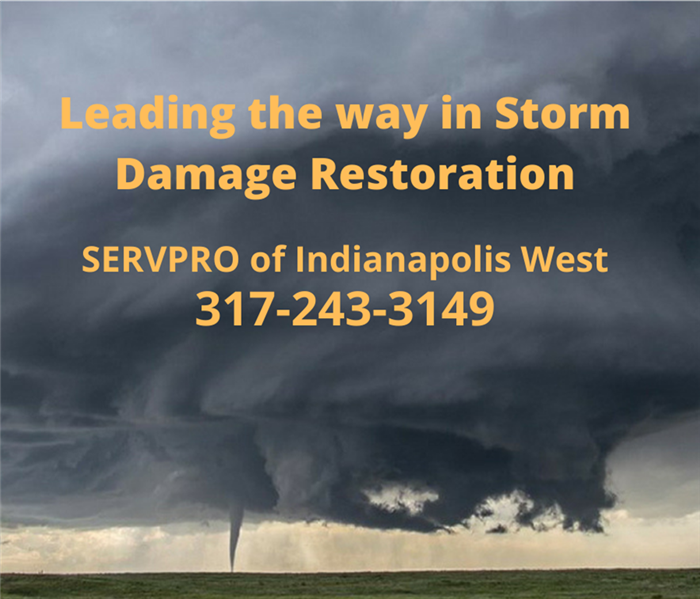 We pride ourselves with fast response and great customer service.
We pride ourselves with fast response and great customer service.
SERVPRO of Indianapolis West is a leader in storm damage cleanup and restoration. Storm damage knows no schedule. We respond 24/7/365 to meet residential and commercial customers' cleanup and restoration needs. Whether it be water damage from a flash flood, roof and window damage from wind and hail, or a fire from a lightning strike, SERVPRO of Indianapolis West has the trained personnel and specialized equipment to handle any size job.
SERVPRO of Indianapolis West has the technology, the equipment, and the expertise to handle any size disaster, anytime, and anywhere. Our team is ready to mobilize and start the cleanup and restoration process 24/7. Our large loss services are much like our small scale restoration services, just more extensive and capable. Large loss recovery services include:
- Water Damage Restoration - Whether from a natural flood or broken water pipes, we can extract the water, dry the damaged area, clean up the mess, and restore your water damaged property quickly and efficiently.
- Fire Damage Restoration - We have the equipment and resources to handle even the largest of fires. We have the expertise to clean up the fire and smoke and restore any damage to the property. SERVPRO has decades of experience removing smoke odor and fire damage.
- Commercial Mold Remediation - Mold can happen slowly or quickly after a devastating flood or sewer backup. Our team has the knowledge and training in mold remediation to ensure mold spores are removed safely and effectively.
- Commercial Cleanup - Our team can provide deep cleaning for facilities that have suffered a viral outbreak, like the recent Coronavirus outbreak. We can also clean up after sewer backups, vandalism, or just from normal wear and tear.
- Storm Damage Restoration - Major storms like tornadoes and hurricanes can bring substantial damage to businesses and homes through flooding, fires, wind damage, and more. Our commercial restoration team is prepared and ready to be on the scene should a major disaster strike.
Time is of the Essence
The quicker you call us, the less secondary damage may occur. The faster we respond, the less amount of business interruption will occur. There's never a convenient time for fire, water, or storm damage to strike your business. We understand that business downtime means lost revenue and no productivity. We'll arrive fast and work diligently to get your business back up and running as quickly as possible.
Our Commitment to the Customer
So when an emergency arises in your home or business, give us a call, and we'll be there fast with the help you need. Our goal is to be "faster to any disaster" meeting our customer's needs. The pros at SERVPRO of Indianapolis West are here to help make it "Like it never even happened."
We're only a call away! Faster to any size disaster. This is not just another tag line for SERVPRO—it is a commitment to be there when you need them most. If you should suffer a fire, water, storm, or mold damage, give SERVPRO of Indianapolis West a call for a fast response to any and every disaster.
Call SERVPRO of Indianapolis West
We live and work in this community, too. We might even be neighbors. SERVPRO of Indianapolis West is close by and ready to respond to your fire, flood, or storm damage emergency in Indianapolis and surrounding areas. We are proud to be an active member of the west side community and want to do our part to make it the best it can be. Click here or call us at 317-243-349.
Summertime Storms In Indianapolis
7/27/2020 (Permalink)
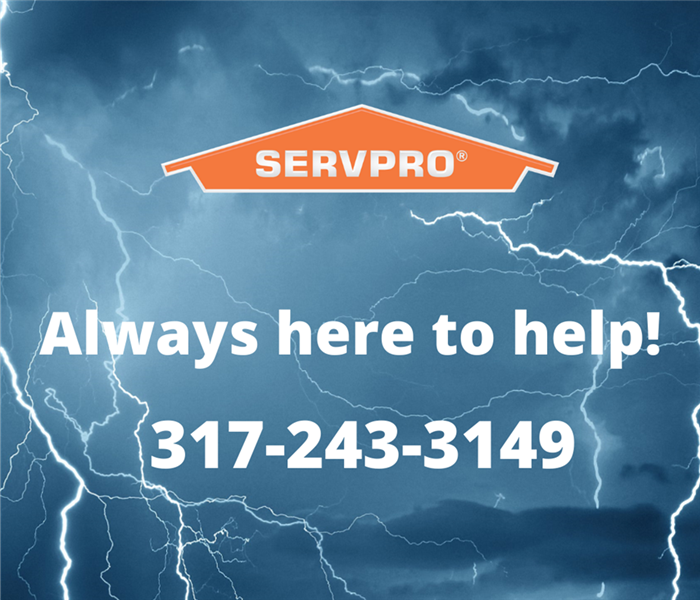 SERVPRO of Indianapolis West is one call away to help restore your property from storm damage.
SERVPRO of Indianapolis West is one call away to help restore your property from storm damage.
If you live in the mid-west or in particular Indianapolis, you know we have all four seasons and their extremes. In winter, we get ice storms, frozen water lines, and sometimes heavy snow. Summertime in Indy brings heat and humidity and many different severe thunderstorms and tornadoes. The summer heat and humidity build through the day, spawning thunderstorms that can drop several inches of water in a short time.
Water Backup
These heavy and sudden rains often overwhelm the sewer systems and cause flash flooding. Homeowners sometimes experience water backups in their basements and crawlspace because the sump pumps cannot keep up or fail after being inundated with so much water in such a short time.
If you have standing water (flooding) in your basement, disconnect the main electrical switch to your home. If you don't know how to do that, call a professional or your local fire department to help you. If you are in doubt about your basement's electrical safety, it's best to stay out of it! Remember, "SAFETY, FIRST!"
Heavy Winds & Lightning
These severe thunderstorms can also cause more than just water damage. Dangerous winds and lightning are also components of these storms. Heavy winds can topple trees, remove shingles, and siding from your home. Even the windows to your home or cars can be broken from flying debris hurling through the air.
A lightning strike can cause a power surge and damage your appliances. That same strike can overheat and melt the protective sleeve of the wiring inside your walls, causing a fire to break out, in your attic, and other hidden areas. The National Fire Protection Association estimates that U.S. local fire departments responded to an estimated average of 22,600 fires started by lightning per year.
Years Of Experience To Better Serve You
SERVPRO Of Indianapolis West has been cleaning and restoring homes and businesses from fire and water loss in Central Indiana since 2007. We've seen storms first-hand many times and are prepared to respond immediately. Call our office if you need water, fire, or storm damage cleanup. If you have an emergency, we will respond immediately.
We live and work in this community too. We might even be neighbors. SERVPRO is part of the Indianapolis, Clermont, and Speedway communities. We are close by and ready to respond to your flood or storm damage emergency. We are proud to be active members of the westside community and want to do our part to make it the best it can be.
Always Here To Help
Whether it be water damage from a flash flood, roof and window damage from wind and hail, or a fire from a lightning strike, SERVPRO of Indianapolis West has the experience and specialized equipment to handle any size disaster. The quicker the response, the less secondary damage that occurs. Our goal is to be faster to any size disaster and make it "Like it never even happened." If you have water, fire, or storm damage, call 317-243-3149, or click here to contact us.
Flash Floods and Tornadoes in Indiana
6/15/2020 (Permalink)
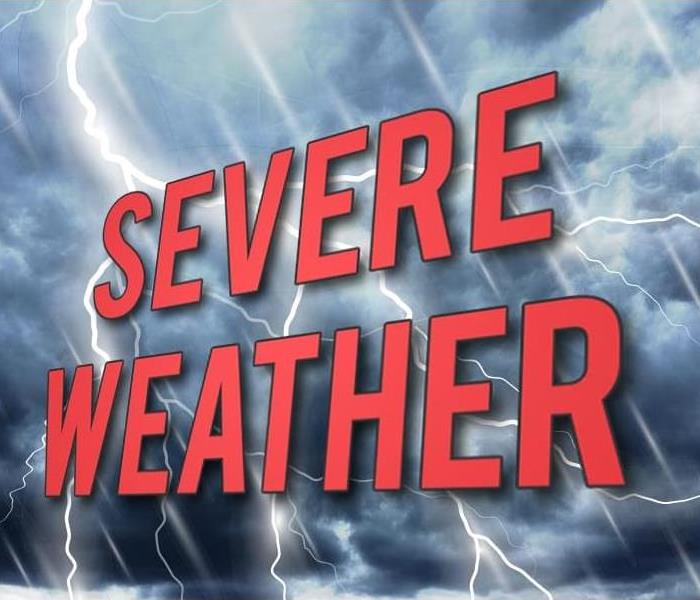 Severe weather is a common occurrence in Central Indiana.
Severe weather is a common occurrence in Central Indiana.
Flash floods are the most dangerous kind of floods because they combine the destructive power of a flood with incredible speed.
Flash floods occur when heavy rainfall exceeds the ability of the ground to absorb it. They also occur when water normally fills dry creeks or streams, or enough water accumulates for streams to overtop their banks, causing rapid rises of water in a short amount of time. They can happen within minutes of the causative rainfall, limiting the time available to warn and protect the public.
Turn Around Don't Drown
People underestimate the force and power of water. This is when cars and trucks are swept downstream. Many of these tragedies are preventable. Never drive around the barriers blocking a flooded road. The road may have collapsed under that water. A mere 6 inches of fast-moving flood water can knock over an adult. It takes just 12 inches of rushing water to carry away most cars, and only 2 feet of rushing water can carry away SUVs and trucks. It is NEVER safe to drive or walk into floodwaters.
Tornado Watch vs. Warning
WARNING means a tornado is already occurring or will occur soon. GO TO YOUR SAFE PLACE IMMEDIATELY.
WATCH means conditions are favorable, and a tornado is possible.
A tornado is a narrow, violently rotating column of air that extends from a thunderstorm to the ground. Because wind is invisible, it is hard to see a tornado unless it forms a condensation funnel made up of water droplets, dust, and debris. Tornadoes can be among the most violent phenomena of all atmospheric storms we experience.
What To Do To Stay Safe
Tornadoes are violent, they can completely destroy well-made structures, uproot trees, and hurl objects through the air like missiles. Although severe tornadoes are most common in the Plains States, they can happen anywhere. Indiana had 39 reported tornadoes in 2019.
Learn what to do to keep your loved ones safe. If you can safely get to a sturdy building, then do so immediately. Go to a safe room, basement, or storm cellar.
If you are in a building with no basement, get to a small interior room on the lowest level. Always think to put the most amount of walls between you and the storm.
If your caught outside and a tornado is approaching, do not get under an overpass or bridge. You're safer in a low, flat location. Always watch out and try to protect yourself from flying debris that can cause injury by using your arms to protect your head and neck.
Flood Damage in Indianapolis and How to Stay Safe
5/29/2020 (Permalink)
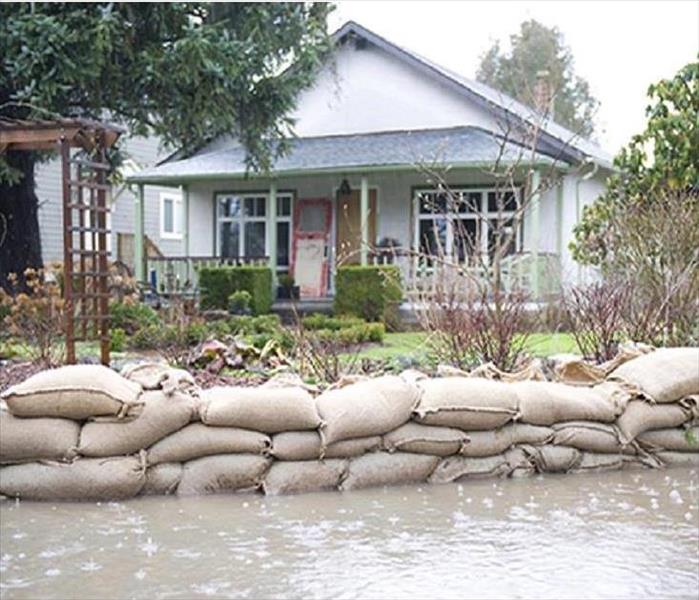 An ounce of prevention is worth a pound of cure.
An ounce of prevention is worth a pound of cure.
Sometimes floods develop slowly in Indianapolis, and forecasters can anticipate where a flood will happen days or weeks before it occurs. Often flash floods can occur within minutes and sometimes without any sign of rain. Being prepared can save your property and give you peace of mind.
Prepare Your Home
1. If you have access to sandbags or other materials, use them to protect your home from floodwaters if you have sufficient time to do so. Filling sandbags can take more time than you may think.
2. Have a professional install check-valves in plumbing to prevent floodwaters from backing up into the drains of your home.
Make sure your sump pump is working and consider having a backup. Make sure your electric circuit breakers, or fuses, are marked for each area of your home.
3. Since standard homeowners insurance doesn't always cover flooding, ensure coverage by contacting your insurance company or agent to purchase flood insurance.
Many flood insurance policies take at least 30 days to go into effect, so even if you can buy it as a storm is approaching, it may not protect your investment.
Create a Communication Plan
It is essential to be able to communicate with your family and friends in the event of a disaster. Having a communication plan in place will give you peace of mind if disaster does strike your Indianapolis home or business.
Predetermine a specific person to contact for status updates. It's also good to have a safe location to meet up with family members.
Assemble an Emergency Kit
It is good practice to have enough food, water, and medicine on hand at all times to last you at least three days in the case of an emergency.
Water service may be interrupted or unsafe to drink, and food requiring little cooking and no refrigeration may be needed if electric power is interrupted.
It would be best if you also had batteries, blankets, flashlights, first aid kit, rubber boots, rubber gloves, and a NOAA Weather Radio or other battery-operated radio readily available.
Call SERVPRO for Help
Flood damage can be devastating to your Indianapolis home or business. Call the storm damage and clean up professionals at SERVPRO of Indianapolis West.317-243-3149
We have the experience and equipment to handle all types of damage from floodwaters, sewage overflows, busted water pipes, and mold growth. We are available 24/7 for any size disaster.
Are You Prepared for Tornado Season?
3/19/2020 (Permalink)
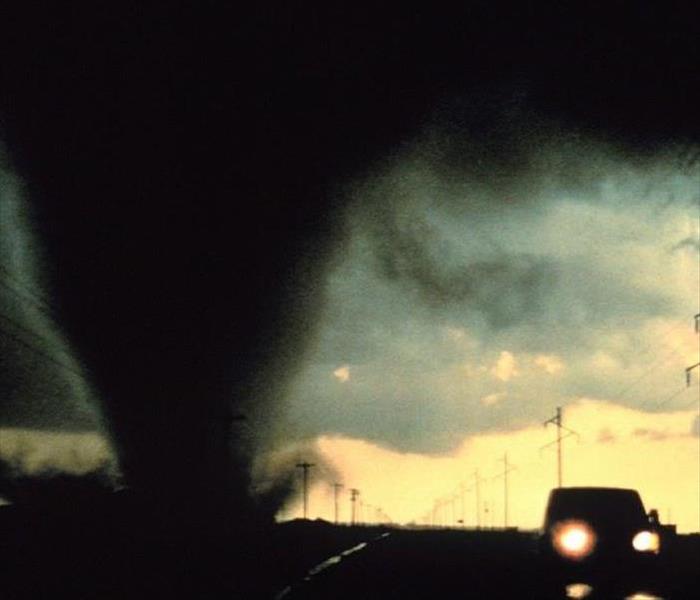 Are You Prepared for Tornado Season?
Are You Prepared for Tornado Season?
This week in Indiana is Severe Weather Preparedness Week. Severe weather in Indiana is usually flooding, heavy rain and wind, and tornadoes. In this blog, we will cover how you and your family can be prepared in the event a tornado is approaching your home and property.
What is a Tornado?
A tornado is a rotating column of air that occurs during a thunderstorm. The wind speed of a tornado can reach up to 300mph. Tornadoes can easily destroy homes and buildings, uproot trees, and hurl vehicles and objects like deadly missiles. Tornadoes can leave a path of damage up to a mile wide and many miles long. Due to the dangerous winds and flying objects, it’s important to seek shelter and hunker down when a tornado is in the area.
Understanding Tornado Watches and Tornado Warnings
If you live in Indiana, you know Spring is the season of tornadoes. With tornadoes, come tornado watches and tornado warnings that are issued by the National Weather Service. So what is the difference between a “watch” and a “warning”? A tornado watch is issued and communicated through radio, television, and the internet when tornadoes are possible in the area. Usually, the area is the path of the storm where tornadoes are possible and can cover one county, multiple counties, or a partial part of a county or counties. When a warning is issued, it’s important to stay tuned in the event the watch turns into a warning. It’s also a good idea to stay inside if you are located in the watch path.
A tornado warning is issued when a tornado has been sighted or spotted by weather radar. If you are in the path of a warning, you need to take immediate action and seek shelter immediately and hunker down. If the tornado warning is not in your area but looks to be heading your way, you need to prepare in case it reaches your home and pay close attention to the radio, television or the Internet for updates. Tornado warnings usually cover a smaller area than a tornado watch.
Preparing for a Tornado
If a tornado is heading towards your home, do you and your family know what to do? It’s important to be prepared in the event of severe weather like tornadoes. With tornadoes, you need to identify a room in your home where you and your family can hunker down and stay safe. The room should be at the lowest level of your home and away from any windows and exterior doors. Usually, the room is in the basement or if there is no basement, a room in the middle of your home, like a closet or bathroom. Also, if you have time, don’t forget your pets if possible. You should also have pillows and blankets to cover up with and stay warm. Also water, food, first aid kit, and flashlights are good things to have in the room if you have time.
During a Tornado
If a tornado is approaching, seek shelter immediately and head to your safe room that you and your family chose in the event of a tornado. Kneel and cover your head. You may also want to cover yourself with blankets to protect yourself from flying debris. If you are outside and can’t make it to your home, seek a low lying area like a ditch. If you are in your home and can’t make it to your safe room, seek shelter in an interior bathroom or closet.
After a Tornado
Once the tornado has passed, check to make sure everyone is accounted for and safe. If there sever damage to your home or water damage, avoid touching any light switches or wires. If the roof or walls are damaged, seek an area of your home that is not damaged or head outside if safe. Damaged walls, ceilings, and roofs can collapse and severely hurt you. Once you and your family are safe, check on your neighbors to make sure they are safe and accounted for. Call 911 if anyone is injured or unaccounted for.
Contact SERVPRO of Indianapolis West for Tornado and Severe Weather Cleanup
If your home been damaged by severe weather or a tornado, contact SERVPRO of Indianapolis West for severe weather cleanup. SERVPRO of Indianapolis West can handle any size disaster from a single home to a whole neighborhood to a twenty store high-rise in Indianapolis. Whether you have water damage, storm damage, fire damage, or all types of damage, SERVPRO of Indianapolis West has the expertise and equipment to handle it. Contact them anytime 24/7 if severe weather hits your home.
Protect Your Home from Winter Storm Damage?
1/10/2020 (Permalink)
 Protect Your Home from Winter Storm Damage?
Protect Your Home from Winter Storm Damage?
With the recent snow in the Indianapolis area, we thought it was a good time to talk about how to protect your home from winter storms. The snow, ice and heavy winds of winter storms can cause substantial damage to your home if not dealt with quickly. In the following blog, we will go over common damages to your home from winter weather and what causes them. We will also cover what you can do to reduce the risk of damage occurring. If your home, or business, should, unfortunately, suffer damage from winter storms this season, you know you can trust the cleanup and restoration experts at SERVPRO of Indianapolis West.
Water Damage from Snow & Ice Melt
After the snow falls, some or all of it eventually starts melting especially around your warm home. As the sun pokes out, the snow melts off of the roof and around the foundation of your home. All of this water will hopefully find its way down through the gutters and away from your home’s foundation. But, if there are any cracks around the windows or foundation or damage to the roof, the water can find its way into your home. You might discover water around a door or window that isn’t sealed completely. You might find a drip from your ceiling or excessive moisture in your basement.
If you do discover a leak around your windows or doors, you will want to make sure you get any cracks or holes sealed up before the next time. If you have a roof leak, you’ll probably want to call a water damage restoration company, like SERVPRO of Indianapolis West, to fix the leak and check for any water damage or mold growth that isn’t visible. If not treated and cleaned up, water damage can cause significant damage to your home’s roof, walls, insulation, structure and more. One last thing to check is to make sure that your gutters are not damaged or clogged and are carrying the melting water away from your home.
Gutter Damage from Ice
Clogged gutters can cause water damage to your home during the warm weather months, but when the temperature drops below freezing, clogged gutters can lead to extensive damage to the gutters themselves. That is because as the water collects in the gutter and freezes, the weight of the ice can tear the gutters away from your home.
To keep this from happening, it’s important to check your gutters to ensure they are clean before the next big snowstorm or severe winter weather hits. When checking and cleaning out your gutters, be very careful and don’t get on the roof when it is wet as you could easily slip and hurt yourself.
Roof Damage from Heavy Snow & Ice
Not only can heavy snow and ice collect in your gutters and destroy them but snow and ice accumulation on your roof can also cause damage to your home. One of the most common damages to homes during heavy snowstorms are roof collapses. It really doesn’t take much snow to cause a roof to collapse. As little as two feet of packed, heavy snow can cause damage or the collapse of a roof.
If the snow has accumulated on your roof beyond two feet, you may want to hire a snow removal service to remove it or you can buy a snow shovel designed to remove snow from roofs. This is a more common problem in Michigan and northern states but excessive snow accumulation on roofs can happen in the Indianapolis area.
Roof Damage from Heavy Winds
Not only can snow and ice cause damage to your roof during the winter months, but severe winds can too. We’ve all experienced those days when the cold wind is blowing so hard that it chills us to our bones. That same wind can also rip off shingles on your home’s roof. With damaged shingles, the snow and melting water can seep into your home and cause extensive water damage.
While you can’t prevent the wind from damaging your roof’s shingles, you can be proactive in looking for damage after severe storms in order to reduce any potential water damage. If you find torn or loose shingles on your roof, you will want to call a roofing contractor as soon as possible to repair the damage. If the damage is severe, you may want to cover it with a tarp until help can arrive to fix it.
Trust the Winter Storm Damage Restoration Experts at SERVPRO of Indianapolis West
If you should suffer damage to your home from winter storms, you can trust the experts at SERVPRO of Indianapolis West to quickly clean up and repair the damage. The pros at SERVPRO of Indianapolis West have years of experience dealing with water damage, mold damage, fire damage and storm damage to homes and businesses around the Indianapolis area. They have the tools and know-how to handle any size disaster and are ready to respond quickly day or night. If your home should suffer damage from the harsh winter weather this season, give SERVPRO of Indianapolis West a call.
How to Prevent Wind Damage to Your Home in Indiana
9/24/2019 (Permalink)
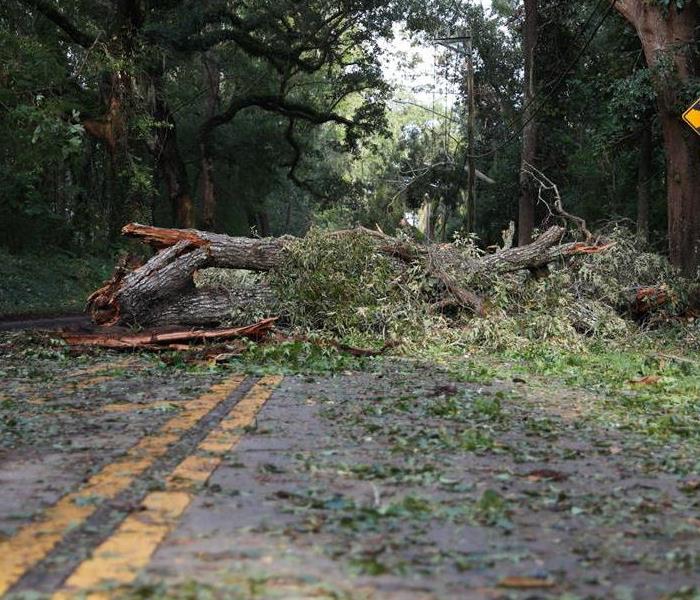 How to Reduce Wind Damage to Your Home
How to Reduce Wind Damage to Your Home
Living in central Indiana, we all are familiar with damaging winds. Due to the lack of hills, mountains, and forests; the wind can be brutal throughout the year. Most of the damaging winds come from thunderstorms and blizzards that blow across our state. Damaging winds are defined as winds that exceed 50mph and are a common occurrence in the Indianapolis area. Another form of damaging winds is tornadoes which are also a common occurrence in Indiana. In the blog below, we will show you how to prepare your home and property for damaging winds. By following these tips, you will hopefully be able to limit the damage that damaging winds can have on your home.
Check Your Garage Door for Weaknesses and Damage
The part of your home that can be most susceptible to damaging winds is your garage door. The best garage door to have is a heavy one. Some of them are even rated for hurricanes. With a heavy garage door, the high winds are less apt to blow or tear it off your home. You can also have your lightweight garage door reinforced by a garage door installer. Whether you have a heavy garage door or a lightweight one, the next important part of the door is how it is secured to your home. You want to check to make sure that the garage door rails are securely attached to the wall and ceiling of your home. If it is not solidly attached, high winds could possibly separate the rails from the home and blow the garage door down. The last part you want to check is the seal at the bottom of the door. Not only will a properly sealed door prevent water from blowing in but it will also keep the wind from shaking the garage door and damaging it.
Check the Integrity of Your Roof
You want to make sure that your roof shingles are not missing or damaged as this can lead to water seeping into your home and causing damage. Make sure that all of the shingles are properly secured and not loose. A loose shingle can be easily blown off the roof damaging and exposing other shingles to wind damage. If you have a satellite dish or air conditioning unit or any other type of equipment secured to the roof, you will want to check that they are solidly affixed to the roof. A satellite dish that blows off a roof can become a dangerous projectile that can damage windows, cars, and other homes. You will also want to make sure that the screws and bolts that are used to attach the equipment to the roof have some type of sealant around them to prevent water from leaking through your roof.
Check Your Windows and Doors
A common source of water damage from high winds and storms is through cracks and broken seals in windows and doors. You not only want to make sure that your windows and doors can close completely and lock but you also want to check the outside frames and edges for any cracks or broken seals. With windows, water can seep in around the wooden frames between the siding and the window. You can easily seal any cracks up with window & door caulking. You also want to check the door jamb for spaces or tears in the weather seal. Many doors have seals that can be replaced easily once they become torn and brittle. You can also buy similar seals for the bottoms of your windows to keep water from blowing under and into your home.
Check the Perimeter of Your Home for Loose Objects
With damaging winds, loose items in your yard, patio, deck, and gardens can quickly become flying objects that can break windows, rip apart siding, dent cars, tear up roofs, and cause all types of damage to you and your neighbors' properties. If you know a severe storm is coming, you want to make sure any table or chairs is secured to the ground and/or moved inside your garage. If you have a grill, move it into your garage or secure it to a deck railing or large tree. If you have any large trees, you will want to cut down any dead branches on a regular basis. Dead branches can easily break during a storm and cause damage to your home. To protect your cars during a severe storm, either move them into your garage or away from any large trees that could fall on them.
If Your Home Should Suffer Storm Damage, Call SERVPRO of Indianapolis West
If your home or property should suffer damage from severe storms, winds, and/or tornadoes, call the damage restoration professionals at SERVPRO of Indianapolis West. They have the knowledge, expertise, tools, and equipment to handle all types and sizes of damage. They’re available 24/7, so don’t hesitate to call them the next time disaster strikes your home or business.
The Dangers of Lightning to Your Indiana Home
7/30/2019 (Permalink)
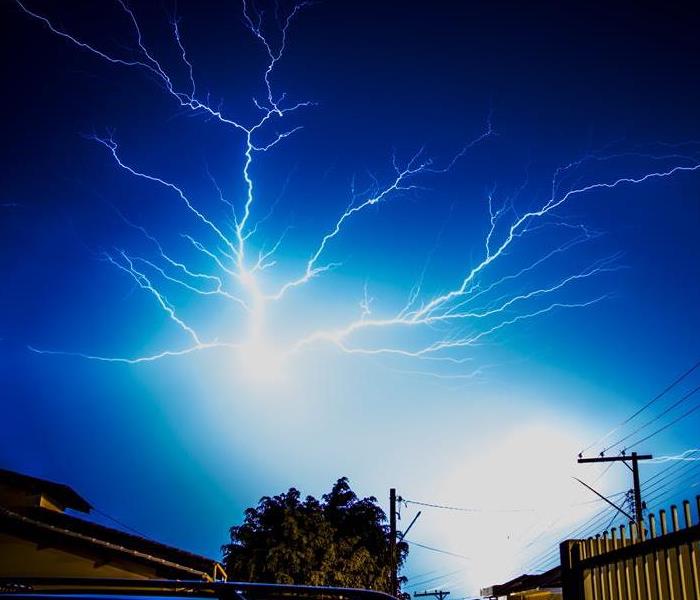 The Dangers of Lightning to Your Indiana Home
The Dangers of Lightning to Your Indiana Home
Lightning occurs millions of times each day around the world. From spring through fall, it is also a common occurrence in Indiana. Lightning is a discharge of static electricity between the positively charged particles on the ground and the negatively charged particles in the clouds. As air moves around and moisture builds up, as in a storm, the opposite charges connect forming lightning. It’s kind of like the static shock you sometimes get while wearing socks on a carpeted surface and touching a metal doorknob, only on a bigger scale.
When lightning connects with the ground, it tends to take the shortest and most attractive path. It tends to connect with conductive materials like a metal antenna on a tall building, a power line, a cell tower, a gutter on the house, a telephone line running to the house, or the metal framing around a window or door. Once the lightning connects with a conductive material, like a TV antenna on the roof of a house, it then travels down through conductive materials until it reaches the ground. These conductive materials could be the electrical wiring in your house, the copper water pipes in your walls, or the TV and internet cables running through your house.
The danger in lightning is two-fold. The first is the high voltage of the lightning. Lightning can easily injure or kill someone if it comes into contact with them. Being struck by lightning is more of a risk when someone is outdoors but can also happen inside if the person is talking on a land phone line or standing in a metal door frame or touching a metal faucet when the lightning strikes. This voltage can also destroy most appliances if the lightning travels through them.
The other big danger of lightning is the amount of heat that it produces. The heat that lightning generates is around 36,000 degrees Fahrenheit. It is this heat that results in house fires from lightning strikes. The heat can easily spark a fire as the lightning travels through or makes contact with flammable materials like wooden framing, insulation, electronics, and gas piping. With gas piping, the lightning can damage a valve which can cause a gas leak which can lead to an explosion.
The power surge and the heat from the lightning can also cause the wiring and connected devices in your home to explode and spark fires. The wiring itself can overheat and melt the protective sleeve causing fires within the walls, in your attic, and other hidden areas.
There is one more big danger of lightning that most people don’t think about. That is shock wave damages. While you may not be familiar with shock waves from lightning, you may know it as a different name - thunder. When lightning strikes, it creates a shockwave or thunder that you can hear from miles away. When lightning strikes nearby, you can sometimes feel the shock waves in the air and through the ground. If you can feel the thunder that far away, imagine what thunder can do to a home from a direct hit? Thunder or shock waves from the lightning can be violent enough that they can shake a brick chimney into a pile of rubble. Lightning can crack cinder blocks, bricks, and foundations on a home. The shockwaves from lightning can blow out windows in a home, which is one of the reasons why you should stay away from windows during a lightning storm.
How to Stay Safe from Lightning in Your Home
When lightning is occurring, you want to stay inside your home until the storm has passed. You also want to stay away from windows as they could carry the lightning as it travels to the ground and/or they could also explode or shatter from the shockwaves. Since lightning seeks conductive materials, you want to avoid touching any electronic devices that are plugged in. You also want to avoid washing your hands, doing laundry, or taking a shower or bath, as lightning can travel through the water pipes and hit you. If you are in a basement with a concrete floor, you will want to wear shoes as the concrete can conduct electricity if it has moisture in it. You can use your cellphone or wireless devices (remote control, wireless telephone, laptop) as long as they aren’t connected to any power source or other powered devices.
What If Lightning Strikes Your Indianapolis Home?
If lightning should strike your home, you will want to do a thorough check of your house. Don’t go outside if the lightning storm has not passed. You can, however, check all the rooms for fire or the smell of smoke. You also want to check your garage and attic if possible. The next step is to call the fire department. Even if you did not spot any fires, a small fire could be smoldering inside your walls or attic, and you won’t know until hours later when it has spread. The fire department will be able to do a more thorough check of your property.
If your home has been damaged by lightning, either as a result of fire or shockwaves, you will want to call the storm restoration experts at SERVPRO of Indianapolis West. They have the tools, equipment, and expertise to handle all types of damage from storms. Whether it is water damage, fire damage, or structural damage from lightning; they can help clean up the damage and get your home back to normal. Give them a call for all of your water, mold, fire, and storm damage.
What to Do If a Tree Falls on Your House?
6/18/2019 (Permalink)
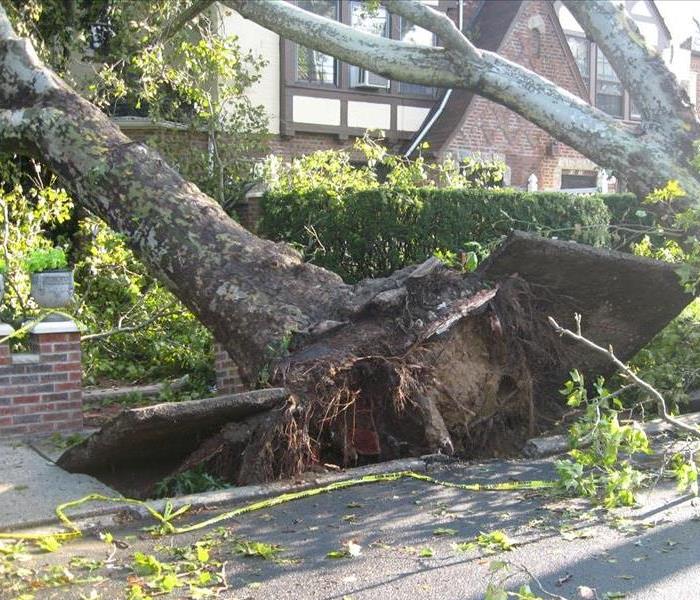 What to Do If a Tree Falls on Your House?
What to Do If a Tree Falls on Your House?
Storm Toppled Trees and Branches
With the recent bout of tornadoes and strong storms throughout Central Indiana, downed trees and branches are an all but common occurrence. Hopefully, though, the down trees and debris have not hit your home or car but have just caused damage to your lawn or landscaping. If a tree limb or whole tree has hit your home, there are some steps you should take to ensure there isn’t further damage and to speed up any recovery efforts. Below we will cover top tips to follow after a tree, limbs, or debris have hit your home after a heavy storm or tornado.
Call the Electric Company if Power Lines Are Down
If you are without power or notice that the tree has hit power lines, stay away from the tree and power lines and call the electric company immediately. They will be able to safely turn off the power to the lines and start working on getting the lines back up.
Evacuate Any Damaged Structures
If a tree has caused significant damage to your home or garage, you will want to vacate the damaged area of the home or structure. The damaged roof or walls of the structure could make the entire structure unstable and at risk of collapsing. If the damage is to a majority of the home, it is best to evacuate the home and seek shelter at a neighbor or in your car away from the fallen tree and damaged home.
Smell Gas, Evacuate the Area
If a tree has fallen and damaged your roof or exterior wall/s, there is a chance that it has also ruptured a gas line in your wall or attic. There is also the possibility of an uprooted tree breaking the gas line under the ground. If you smell gas in or around your home, you should immediately leave the area and call 911. The police will contact the gas company to shut off the gas line in your area.
Water Damage from Damaged Roof, Walls, or Windows
If you notice water leaking into your home from the damage caused by the downed tree or branches, you will want to call a water damage restoration company, like SERVPRO of Indianapolis West, immediately to cover the damaged area and clean up any water damage inside your home. This will keep any further rain from entering into your home and dry up any water that has already entered. The faster this is done, the less damage your home will incur from water and mold.
Does Home Insurance Cover Damage from Fallen Trees?
A common question many people have is whether their home insurance will cover damage caused by a fallen tree or branches. If the fallen tree damaged your home, garage, or detached structures like a barn or shed, more likely than not, your home insurance will cover the damage. If the fallen tree just causes damage to your lawn or landscaping, it’s unlikely your home insurance will cover the damage. It really all depends on your home insurance company and policy. You should contact your insurance agent for clarification on what is covered and what isn’t.
How to Prevent It from Happening Again
While you could remove all the trees from around your property to greatly reduce potential damage from a fallen tree to your home, this is an unlikely and unpopular scenario amongst most people who appreciate having shade trees and ornamental trees around their homes. One tip you could follow to reduce any fallen branches or downed trees from damaging your home is to practice some routine clean up and maintenance on your trees each year. Once a year, Spring is usually the best time, it’s a good idea to cut down any dead branches, leaning branches, or damaged branches that may break or fall during a storm. If you find any dead trees or unhealthy trees, you may consider hiring an arborist to determine if the tree can be revived or cut down. By keeping your trees in healthy condition, you can reduce the risk of one toppling or breaking as a result of strong winds and heavy rains.
Prevent Further Water Damage. Contact SERVPRO of Indianapolis West.
If you should experience water damage to your home or property from a downed tree or branches, call the water damage restoration experts at SERVPRO of Indianapolis West. They have the equipment and the expertise to stop any further damage from happening and quickly clean up and restore the water damage that has already occurred. They can also help with any mold damage or fire damage if needed. They’re available 24/7 for any size disaster. Give them a call if disaster strikes and damages your home.
After the Flood - The Do’s and Don'ts
5/29/2019 (Permalink)
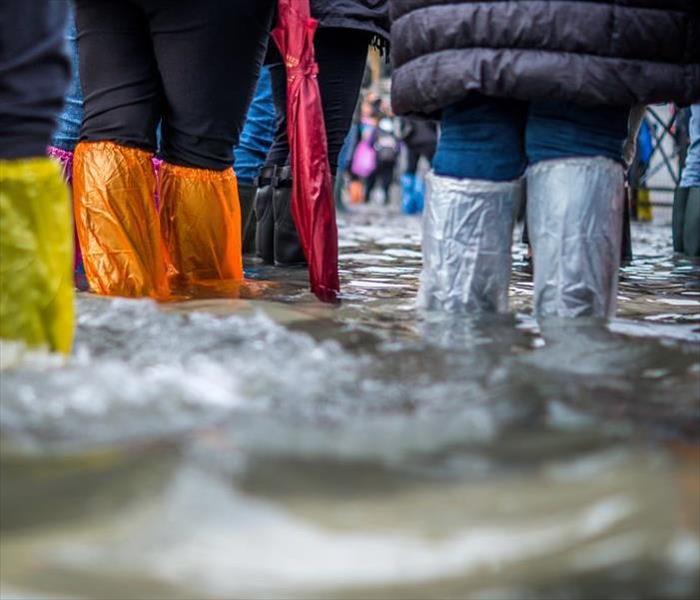 After the Flood - The Do’s and Don'ts
After the Flood - The Do’s and Don'ts
Floods can be devastating to Indianapolis homes and businesses. Not only can the initial flood waters cause extensive damage but so can the potential mold growth afterward. Before returning to your flood-damaged home, there are things you should do and not do after the flooding.
Wait Until the All Clear
Flood water can be deceiving. While it may seem that the waters have stopped rising or have receded, they can quickly rise as the rivers and streams bring more water from upstream. The best thing to do before even attempting to return to your home is to confirm with the emergency services that it is safe to do so. If there are fire or police in the area, you can also ask them if it is safe to enter your home.
Inspect the Exterior for Damage
Before entering your home, walk around the perimeter of your home to check for any damage to the exterior, downed power lines, or ruptured gas lines. If you smell gas or see a downed power line, leave immediately and contact the authorities. They will contact the utility companies to ensure the power is off and/or the gas line is shut. Do not go back until you have confirmed that there is no danger of electrocution or gas explosion. You also want to check for any structural damage to your home. If the roof is collapsed or sagging or the walls are buckled or heavily damaged, you shouldn’t enter your home as it could be unstable and at risk of collapsing.
Do Not Enter Flooded Floors
If your basement, lower level, or first floor are flooded, do not enter the floors. The water could be hiding hidden dangers like sharp objects, snakes, chemicals, and dangerous bacteria. If the water is flooded in the lower levels of your home, you will want to pump out the water first. Once the water has been cleared out, then comes the messy cleanup. Flood water can be a toxic stew of things that can harm your health. That’s why it’s a good idea to wear rubber boots and gloves to protect yourself from any chemical or waste residues.
Get Rid of Water Damaged Goods
If any of your food has gotten wet from the flood waters, you should throw it away. If your refrigerator has gone without power for a while, you’ll also want to empty it before mold takes hold and makes a bigger mess of your fridge. It’s advisable to remove as many water-logged materials like papers, clothes, storage boxes, fabric furniture, drywall, curtains, and carpets. As you can see this can be a huge and overwhelming job. That’s why it’s usually a better idea to have a professional flood restoration company do this all for you.
Don’t Risk Further Damage. Contact SERVPRO of Indianapolis West.
Flood damage can be devastating especially if you don’t act fast and don’t remove all of the damage. To ensure all of the flood waters and water damage are removed, it’s best to call the storm damage and clean up professionals at SERVPRO of Indianapolis West. They have the expertise and equipment to handle all types of damage from flood waters, sewage overflows, busted water pipes, and mold growth. They’re available 24/7 for any size disaster. Give them a call if disaster strikes your home.
Spring Storm Restoration Service In Indianapolis
5/9/2019 (Permalink)
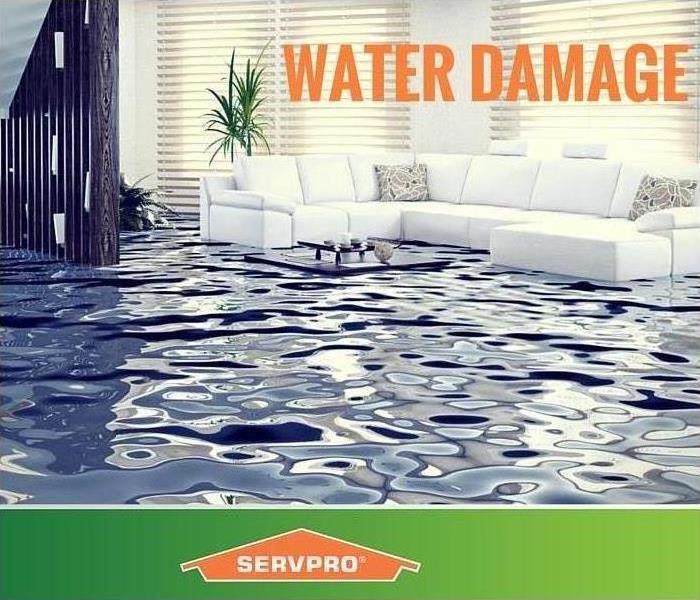 We can help when water invades your property.
We can help when water invades your property.
Springtime Rain Can Be A Pain
With all this rain recently in Indianapolis and more on its way, sump pumps are being overworked and overwhelmed. Some pumps seem to be working correctly but still allow water to back up in the basement or crawlspace. If you have standing water (flooding) in your basement, disconnect the main electrical switch, call a professional or your local fire department to help you. If you are in doubt about the electrical safety of your basement, it's best to stay out of it! Remember, "SAFETY FIRST!"
Certified Training To Get The Job Done Right
Call SERVPRO of Indianapolis West and our Certified Water Restoration Technicians will make it "Like it never even happened." The water removal and water cleanup process are completed by our highly-trained technicians who will document the drying process, and this validates that your property was dried thoroughly and accurately. We're routinely called to homes and business all across Indianapolis to clean up after a flood has occurred. We feel like we've seen just about everything and can handle any Fire or Water Restoration job that comes our way. When Indianapolis experiences heavy rains and strong storms, SERVPRO of Indianapolis West has the training and experience to return your home or business to its preloss condition. Our highly trained crews have the specialized equipment and resources to handle the job, large or small, residential and commercial.
One Call Away To Save The Day
When water damage strikes, a fast response is critical. Day or night, Indianapolis residents and business owners can expect us to respond immediately to your water emergency. Our office is strategically located in Indianapolis, and that gives us the ability to act fast and arrive "Faster to Any Size Disaster."
Call us, SERVPRO of Indianapolis West, we always have a live SERVPRO representative to help answer your questions and dispatch a crew 24/7 for emergency services. 317-243-3149
How Winter Storms Can Damage Your Indiana Home
1/22/2019 (Permalink)
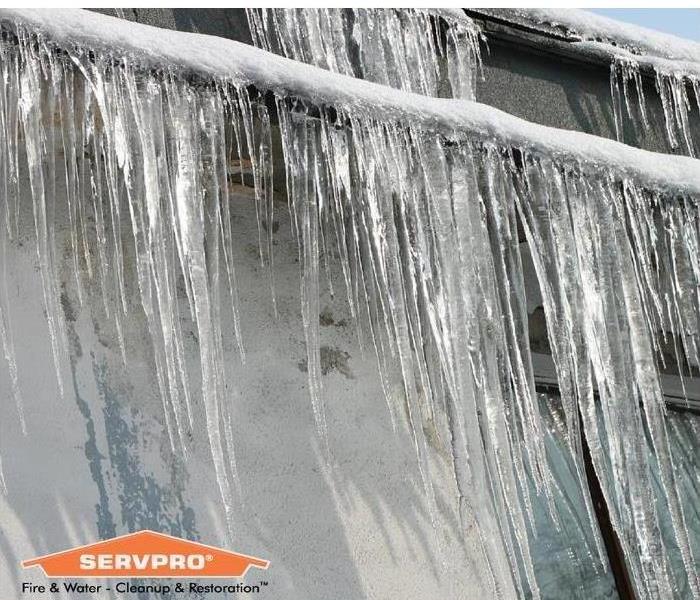 Ice can be particularly damaging to your Indianapolis home or business.
Ice can be particularly damaging to your Indianapolis home or business.
When we think about damaging storms, we tend to think of warm weather storms during Spring, Summer, and Fall. We don’t tend to think of winter storms as being extremely dangerous and damaging to homes. You might be surprised to learn that winter storms are the most damaging type of storm behind hurricanes and tornadoes.
While summer storms can bring high winds, flooding, and lightning; winter storms can bring some of the same and more like ice and snow. Below we will cover the damaging aspects of a winter storm and what steps you can take to reduce the risk of damage to your Indiana home.
Ice Damage
The first thing we think about when discussing the dangers of ice are slip and falls. Slip and falls along your sidewalk, driveway, deck, and patio are common and can result in broken bones. But ice can also cause damage to your home. Falling ice from trees and power lines can damage your roof. Ice accumulation in your gutters can cause them to break away from your home. Ice build up on your roof can cause the most damage as the weight of the ice can eventually cause your roof to collapse. Even if ice on your roof doesn’t cause it to collapse or bow, it can also cause water to seep under your shingles and cause water damage in your attic.
Some steps you can take to prevent this is to check to make sure your gutters aren’t clogged. It’s usually best and safest to clean your gutters out once all of the leaves have fallen from the trees around your home. Usually, the temperatures are still bearable and you can find a day where the roof is dry. Once you start having snow accumulations, you need to check your roof on a regular basis to make sure the snow isn’t piling up. As the snow piles up, it can melt and refreeze causing ice dams on your roof. These ice dams can keep the snow melt from flowing off your roof. Instead, the ice can build up and lead to leaks or collapses. A long handle broom or rake can help know off the snow or break up the ice dams.
Wind Damage
Winter storms can bring bitterly cold, high-speed winds which can wreak havoc on a home. These winds can blow snow, ice, and water under shingles, into foundation cracks, in cracks around your windows and doors, and through an attic and crawl space vents. They can also blow tree limbs and ice into your siding and windows causing damage and breaks.
While you can take some steps to reduce the risk of ice damage, there’s not much you can do to keep the high winds at bay. The best thing is to check around your home for any signs of damage after a winter storm. Look for damages to your siding, shingles, and windows. If the wind has blown snow up against your home, you will want to shovel it away. Snow buildup can cause water damage to your siding and foundation as it melts and refreezes.
Flooding After the Snow
During the really big snowstorms that usually only happen every few years in Indiana, the melting snow can be as dangerous and damaging as the snow itself. The snow itself can lead to roof collapses if the snow is wet and heavy and deep. But if the temperatures all of a sudden swing above freezing temperatures, the melting snow can cause flooding. Since the ground in Indiana is usually saturated during the winter months, the melting snow can quickly cause flooding in low and high areas.
To keep the flood waters from damaging your home, you want to make sure to shovel as much snow as possible away from your home’s exterior. If you have storms drains near your home, you want to check them regularly to make sure they don’t get clogged from the snow melts. If the snow builds up against your exterior and it starts to melt, the water can seep through your windows and doors that the snow has covered. This is why it’s important to shovel away the excess snow before it has time to melt.
Winter Storms Can Be Messy
Winter storms can be messy in Indiana. Not only do they make driving and walking even more dangerous, but they can also wreak havoc on your home. If you should experience water damage, mold damage, and/or fire damage from a winter storm, contact the cleanup experts at SERVPRO of Indianapolis West. They have the tools, equipment, and know-how to clean up and repair the damage caused to your home. Give them call any time and any day for your winter storm damage emergency.
Is Your Home Ready for the Harsh Indiana Winters?
12/13/2018 (Permalink)
 Is Your Home Ready for the Harsh Indiana Winters?
Is Your Home Ready for the Harsh Indiana Winters?
This winter is supposed to be really bad in Indiana with lots of snow and extremely cold temperatures. With Christmas just around the corner and lots of us taking a day or two off from work, now might be a good time to make sure your home is prepped and ready for the harsh Indiana winter weather. In this blog, we will go over steps and tips to take to reduce the risk of water and mold damage to your Indiana home.
Clean the Gutters and Roof
Now that all the leaves have fallen off the trees, you will want to check your gutters to make sure they are clean. If they full or clogged, they could become damaged over the winter as water pools and freezes in the gutters putting excessive weight on them. You’ll also want to make sure any dead branches are removed off the roof and make sure that the water from the gutters is flowing away from your home and its foundation. It’s best to choose a day that is dry to clean out your gutters as roofs can be slippery and dangerous when wet.
You also may want to trim back any branches, especially dead ones, to keep them from breaking and falling on your roof over the winter. While you are on the roof, you’ll also want to check the flashing around the chimney and the seals around the exhaust pipes on your roof to make sure no water finds its way into your home.
Check Seals Around Windows and Doors
Once you're done with cleaning out the gutters and checking the roof, you’ll want to walk around the house and check all of your windows and doors for broken seals, cracks, or other areas where the cold air and water can get into your home.
You also want to check around your foundation for standing water and cracks in the foundation. Cracks in the foundation can get worse in the winter as water seeps into the cracks and freeze causing expansion and further damage to your foundation. If you find cracks, you will want to seal them before they get worse. If you find standing water you may want to make sure your gutters are directing the water away from your home and grading the ground to slope away from your home’s foundation.
Check for Leaks and Water in Your Basement and Crawl Space
Indiana winters tend to be very wet keeping the ground around your home saturated. With so much water and moisture outside, it’s important to check your crawl space and basement for water leaks and high moisture. You want to seal any cracks or leaks and possibly use a dehumidifier to remove the excess moisture out of the air. If the moisture is too high, it can lead to mold growth in your crawl space and/or basement. You also want to test your sump pump to make sure it is working properly.
Insulate Pipes and Turn Off Faucets
While you are in the basement and crawl space, you will want to cut off the water to your outside faucets to reduce the risk of them freezing and bursting. You also may want to insulate and exposed water pipes in your crawl space and/or basement. This is an especially important step to take in a crawl space as crawl spaces tend not to be insulated or heated and can get extremely cold in the winter. Under the most extreme cold temperatures, water pipes could freeze and burst.
Change Out Air and Furnace Filters
Changing out your furnace filter will not only reduce the wear and tear on your furnace, but it will also reduce the risk of fire. With a dirty furnace filter, dust can quickly build up and your heater will be operating more often to keep your home warm. The excess dust and the heater working overtime can increase the risk of fire as the dust can be combustible. It’s also not good for the air quality or your utility bill.
If you have other air filters, make sure to check them out and replace them if needed also. Another risk from the excess dust is mold growth. If the humidity is too high in the air, it can increase the chance of mold growing on the dust in your air ducts.
Get Prepared for Indiana Winters
By taking the steps mentioned above, you can greatly reduce the chance of water, mold and/or fire damage to your home. If you should experience water, fire or mold damage to your home this winter, it’s important to act quickly to reduce further damage and call the experts at SERVPRO of Indianapolis West. They have the expertise and equipment to handle any Indiana winter home and business emergency. Even a small leak can result in extensive water and mold damage if not dealt with quickly. Give them a call any time and any day for your fire, water and mold damage problems.
Flash Floods Can Be Dangerous
8/7/2018 (Permalink)
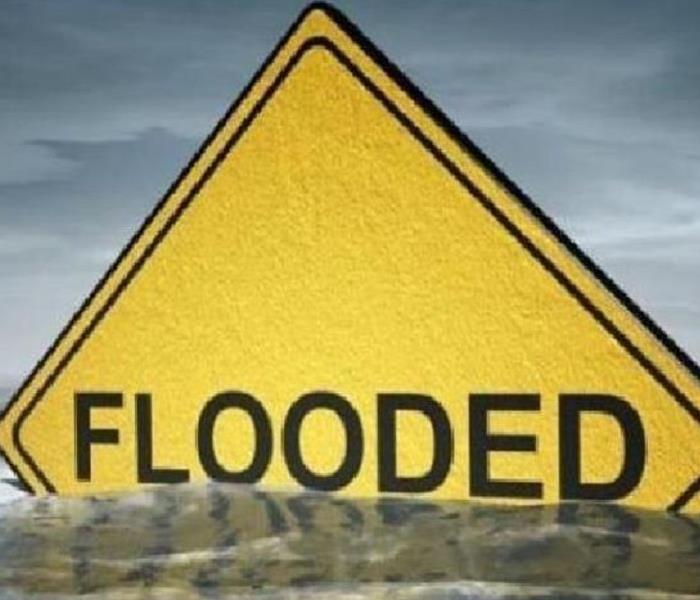 Flash floods can happen just about anywhere at anytime.
Flash floods can happen just about anywhere at anytime.
By definition, a “flash flood” is a sudden local flood, usually due to extreme heavy rainfall from thunderstorms. Flash floods come quickly and sometimes with little to no warning. Flash flooding can happen so quickly that people are caught off guard. If you encounter high or fast-moving water while traveling, stop, “Turn Around, Don’t Drown.”
Don’t take a chance you may regret.
It’s sometimes easy to underestimate the power and force of moving water. Just six inches of moving water can knock you down, and one foot of moving water can sweep away a vehicle. People can be caught in their cars and swept downstream causing serious injuries and even death. Many of these drowning deaths each year are due to careless drivers and can be prevented, but too many people continue to ignore and drive around barriers that warn them of flooded roadways. Even driving through standing water can be dangerous. If the water isn’t moving, or cannot sweep your car away, it can stall your engine leaving you stranded and causing long-term damage to it.
Am I safe from flooding if I live Downtown?
A lot of people live in downtown Indianapolis and should be aware of possible flash floods. Flooding can happen almost anywhere, even in urban areas because of the impenetrable ground. The rain water cannot soak into the ground due to the impervious nature of concrete and the lack of open soil in urban environments. Massive amounts of water run-off can then overwhelm the sewer systems. Sewers can quickly become clogged by debris resulting in the water to backup and then flood. If you’re caught in a flash flood, stay safe and in your car if possible, and use your emergency kit.
Some items your emergency kit may include:
- Water- one gallon per person for at least three days.
- Food- at least a three day supply of non-perishable food.
- Battery powered or hand crank radio
- Flashlight.
- Extra batteries.
- Candles.
- Phone chargers.
- Road flares.
- Rain ponchos.
- Tarp.
- Wet wipes.
- A whistle to signal for help.
So while I write this blog as content for our website, I also hope that by reading this you will think twice next time you see a flooded roadway and turn around. It’s best if you take a few extra minutes and find an alternate route to your destination. So remember to "Turn Around, Don’t Drown," someone out there will be glad you did.
Tornado Preparedness
7/26/2018 (Permalink)
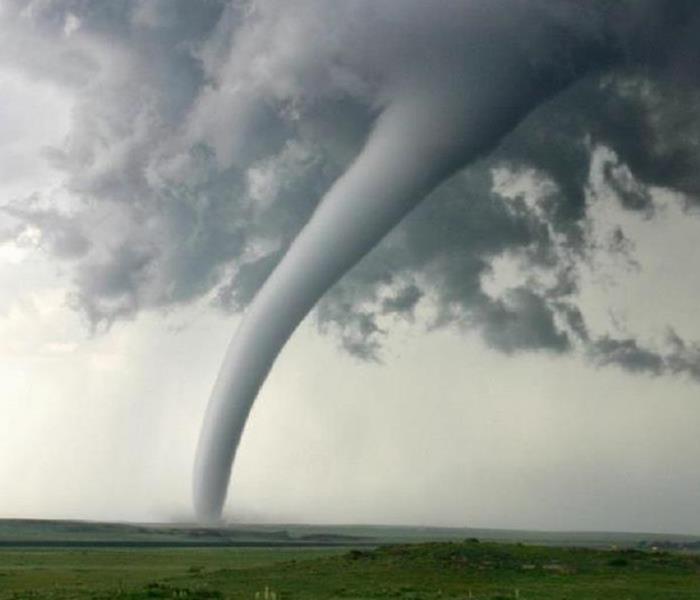 Be as prepared as possible, talk to your family about tornado safety.
Be as prepared as possible, talk to your family about tornado safety.
Summer is in full swing and that means thunderstorms and severe weather can occur at any time. We watch the news channels whenever strong storms are predicted so that we can be prepared and help keep our families safe. When strong storms are in your area, or the potential for strong storms, the National Weather Service may issue tornado watches and warnings.
Tornado Watch vs. Warning
What's the difference between a tornado watch and a tornado warning?
A “watch” is issued when conditions are favorable for storms and tornadoes to be produced. This doesn’t necessarily mean there is a storm in your area, but that there is a high potential for one to be produced. A “warning” means that severe weather is imminent and a storm or tornado has been spotted in your area and you should seek shelter immediately.
Where to go and what to do:
Here are a few things we can do to stay safe and help protect ourselves if a storm is near. Get all family members and pets to an interior room, hallway or stairwell, the more walls between you and the storm the better. Get under a sturdy piece of furniture and protect your head. Move away from windows, and be sure to keep them closed, as high winds and dangerous debris can enter if they’re left open. Other safe places during a tornado can be a cellar, storm shelter or the basement of your home, any interior rooms without windows such as bathrooms and closets.
If your caught outside during a tornado seek shelter immediately. If that’s not an option, lie flat face-down on low ground, protecting your head with your arms. Get as far away from trees and cars as you can, they can be blown onto you in a tornado. Seeking shelter under an overpass is more dangerous than standing in an open field while a tornado is approaching. When a tornado passes over an overpass, the wind is funneled under the bridge, this actually increases its velocity. Additionally, overpasses are often where debris tends collect. So you’re better off finding a low area of the ground and laying as flat as you can. Be aware of flash flooding in these low areas.
Preparedness is so important.
It’s a good idea to talk with your family and plan out what to do and where to go in the event of a tornado. Preparation is very important and something we should all take time for. Select an area of the home to go to in the event of a storm and talk about it with the family. Also, keeping an emergency supply kit in that room is a very good idea. Items for a home emergency supply kit can include: water, food, a battery powered radio, flashlight, first aid kit and a whistle to signal for help.
What is a tornado?
A tornado is a violent rotating column of air extending from a thunderstorm to the ground. Because wind is invisible, it is hard to see a tornado unless it forms a condensation funnel made up of water droplets, dust and debris. Tornadoes are the most violent of all atmospheric storms. The most violent tornadoes are capable of winds up to 300 mph and can create tremendous damage. They can destroy large buildings, uproot trees and hurl cars and trucks hundreds of yards.
Where do Tornadoes most often occur?
Tornadoes are most common in the central part of the United States, also known as the Great Plains. This area is suited to bring all of the ingredients together to form tornadoes. More than 500 tornadoes typically occur in this area every year and is why it is commonly known as “Tornado Alley.
Warning signs that a tornado might be near.
There are several atmospheric changes that might be warning signs of a tornado’s arrival. A dark greenish sky, wall clouds or an approaching cloud of debris and large hail in the absence or rain may indicate a tornado is near. Also, before a tornado strikes, the wind may calm down and the air become very still, the “calm before the storm.”
What to Check After a Hail Storm
7/25/2018 (Permalink)
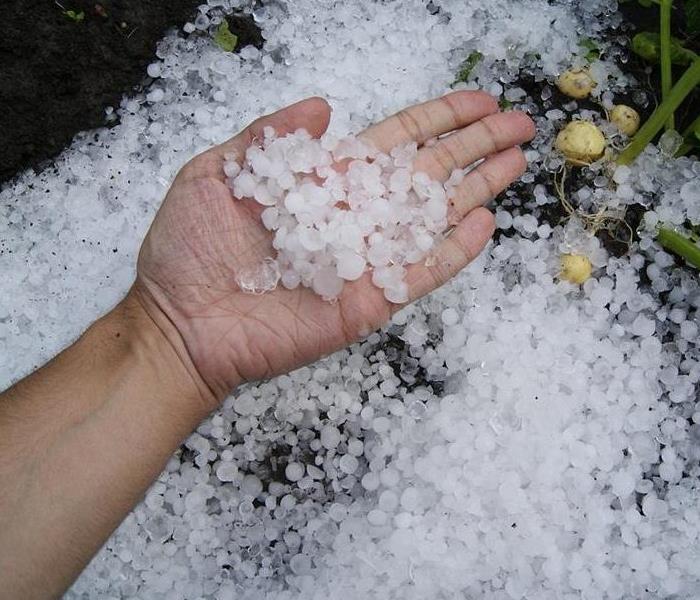 What to Check After a Hail Storm
What to Check After a Hail Storm
While hail is a pretty cool phenomenon when seen on TV or from afar, it’s a scary and many times dangerous situation when experienced first hand. These frozen balls of ice falling from the sky can cause a lot of damage to cars, businesses, and homes. So if you should experience a hail storm, the first step is to take immediate cover. Once the storm has passed, it’s then a good time to check your property for damage. Below we will cover common areas to check around your home and business for damage from hail.
The Damage Hail Can Cause
When it comes to hail damage, the first thing many people think of is cars. We’ve all seen the news stories where cars are pelted with hail during a storm creating little dents in the car hoods and roofs. But what most people don’t think about is that if hail can cause that damage to metal, imagine what it can do to a home or business?
Check the Roof
One of the most common damages from hail is damage to a roof. The hail can tear up the shingles of a home resulting in roof leaks. Even if there are no signs of leaks from the roof damage, you may still want to check for any dings or pot marks in the shingles. If there is enough damage, many times the insurance company will cover the damages due to the hail storm.
Check the Siding
Another common area of homes that hail can damage is the siding. This is particularly true with old, brittle siding. If the hail storm brings with it high winds, the hail can be blown into the siding of homes rather than dropping straight down. The hail can tear apart the shingles causing water to seep into the exterior walls resulting in water damage to the insulation, the wood framing, and eventually into the drywall.
Check the Windows
Again, if the hail storm has severe winds, the hail can be blown into windows and doors causing glass cracks or breaks. Even if the windows and doors are broken, the hail can also cause damage to the seals around the windows and glass which can lead to water seeping into the home. It’s always a good idea to do a thorough check of all the windows and doors that were hit by hail for any damages.
Check the Air Conditioner
Luckily there’s only one major appliance that is found on the outside of the home. That is the air conditioner. While air conditioners are usually built to withstand the brutal Indiana seasonal weather, large and damaging hail storms is one thing that air conditioners may not be able to stand. The hail can damage the cooling coils of the air conditioner. The coils are usually protected by a wire cage to can block objects from hitting the coils directly, hail is usually small enough that it can pass by the cage and cause direct damage to the coils. In severe hail storms, hail can also damage any wires or power supplies to the air conditioner. Again, it’s always a good idea to check the air conditioner and make sure nothing has been blown into it during the storm or been damaged from the hail.
Check the Gutters
Not only can hail dent and ding the gutter system, it can also cause further damage from the weight of the hail piling up into the gutter system. It’s not uncommon to see a gutter system pulled or torn away from a home due to the excessive weight of the hail piling up in the gutters. If you are up on the roof to check for damage to the shingles, you can also check the gutters for damage too. Look for dents in the gutter systems and areas where the gutter is drooping or even pulled away from the house.
Call the Hail & Storm Damage Cleanup Experts
If you should suffer hail and storm damage to your home, call the cleanup experts at SERVPRO of Indianapolis West. They have the knowledge and expertise to handle any type of storm damage. With their extensive training and state-of-the-art equipment, the pros at SERVPRO of Indianapolis West can handle water and mold damage that can result from heavy hail storms, wind damage, and flooding.
What to Do if You Have to Wait for Service After a Storm in Indianapolis
7/22/2018 (Permalink)
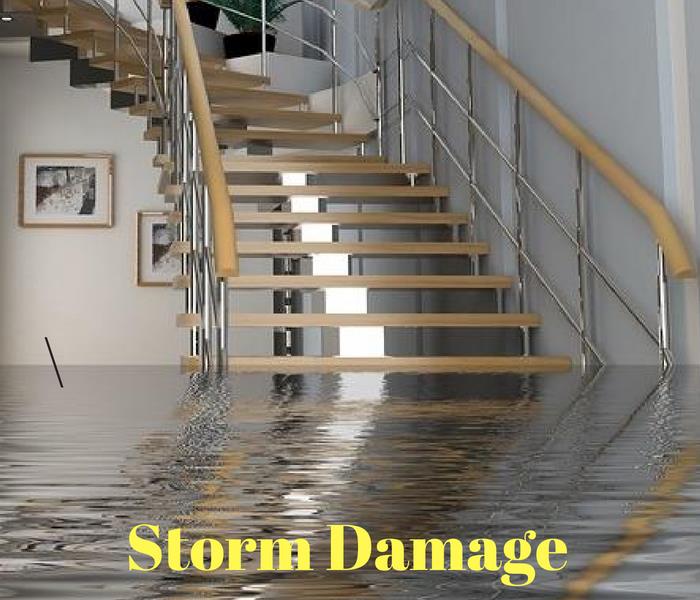 Heavy storms can leave your Indianapolis home or business flooded.
Heavy storms can leave your Indianapolis home or business flooded.
When a major storm event occurs, widespread flooding will likely accompany it. Whether it's a deep freeze in the winter causing broken pipes or torrential spring and summertime rain overwhelming sump pumps, these devastating storms can leave hundreds or thousands of homes and businesses damaged and flooded.
Beware of the door-to-door salesman
Watch out for door-to-door sales companies wanting to service your home. Always make sure you hire a reputable restoration company recognized in the industry. Do not pay in advance for any service to these door-to-door companies. They’re usually not prepared or able to handle your claim.
Patience is a Virtue
Many so-called contractors out there look to make a quick buck and take advantage of homeowners at their most vulnerable time. Honest and reputable companies will have well-marked service vehicles and uniformed crews that and can provide business insurance and customer testimonials. They should also give you straightforward and easy to understand answers and be able to explain the restoration process fully.
Immediately after major storm events, restoration companies are inundated with emergency service calls to cleanup and dry out homes and business. These extreme storms are rare, and when they happen, you may have to wait for your property to be serviced. We wish we could get to everyone all at once, but unfortunately, that’s just not possible. Our emergency service crews work 24 hours a day after these storms to restore your home or business. While you may have to wait for service, there are some things you can do until help arrives. Always think “Safety First” and use extreme caution after storm and flooding damage.
What You Can Do Until Help Arrives:
Be extremely careful and make sure it’s safe to enter a wet area.
Avoid going into rooms with wet and sagging ceilings.
Avoid using any appliances or electronics that may be wet.
Remove excess water by mopping and blotting, Do not use your house vacuum.
Remove or elevate small items from the floor that can be damaged by standing water.
If possible, remove excess water from wood furniture with a soft towel.
Remove couch and chair cushions and place them in a dry space.
Use aluminum foil or small wood blocks between furniture legs and wet carpeting. This will help prevent the stain in furniture legs from transferring to the carpet.
If possible, turn on the air conditioning; this helps remove moisture from the air and promotes drying.
Pickup rugs from the floor or carpeting and put them in a dry room.
Remove paintings and artwork to a safe, dry place.
Gather loose items from floors. This will make a more safe environment and help keep them dry.
Reasons to use SERVPRO of Indianapolis West to restore your property:
SERVPRO is a trusted leader in the fire and water cleanup and restoration industry.
SERVPRO of Indianapolis West is locally owned and operated and part of the Indianapolis community.
We are also part of a national network of over 1,700 SERVPRO franchises, which enables us to respond quicker and with more resources.
When major storm events occur, we can call on our special Disaster Recovery Teams strategically located throughout the Midwest.
We have agreements with most insurance companies in central Indiana and will help you process your insurance claim.
We will explain our process up front so that you know our every step and what needs to be done to ensure your property is fully restored.
We monitor and document the drying process to ensure your home is completely ready.
Our restoration technicians are certified and have continuing education in the industry.
You will have only one point of contact throughout the process. SERVPRO of Indianapolis West will manage all phases of the project from beginning to end.
You can always contact us 24/7 for emergency service . We are always available to answer any questions you may have.
Preparing Your Indianapolis Home or Business for Floods and Storms
6/26/2018 (Permalink)
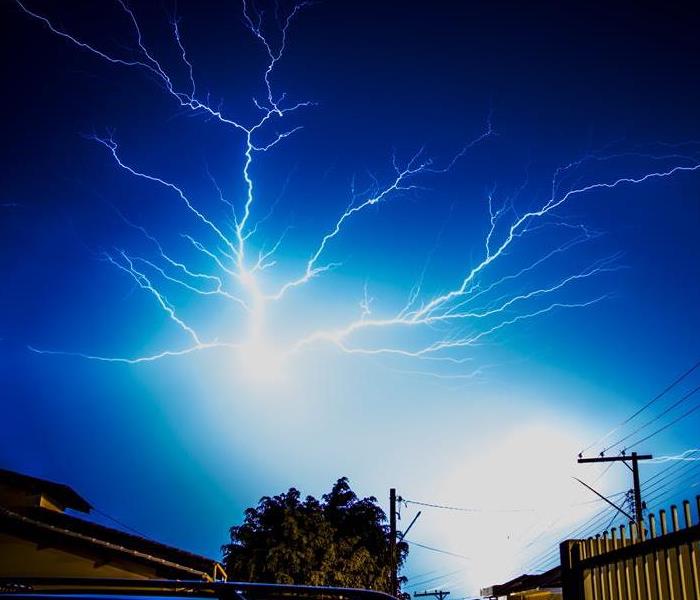 Preparing Your Indianapolis Home or Business for Floods
Preparing Your Indianapolis Home or Business for Floods
While the Summers in Indiana can bring lots of heat and drought, they can also bring lots of thunder, lightning, and flooding. Before the weather outside starts looking dark and gloomy, make sure that your Indianapolis home and/or business is prepared. Below, we will cover what you need to do in the event of heavy storms and flooding in order to reduce any potential damages to your property.
Batten Down the Hatches
Before the storms come, there are some steps you can take to minimize any potential damages from strong storms and potential flooding. If you know a heavy storm is coming and you have time, follow these steps:
- Make sure all your windows are shut and closed.
- Bring in or tie down any outside furniture.
- Make sure your gutters are clean to allow water to flow away from your home.
- Test your sump pump in your basement if you have one.
- Cut down any dead branches or limbs around your home.
- Seal any water leaks on your roof if possible.
Prepare for No Power
Strong storms can bring heavy winds which can cause power outages. Even a few hours of no power can be difficult to handle especially with young children. Follow these steps to make any power outages more tolerable:
- Have flashlights and plenty of batteries easily available.
- Make sure your cell phones are fully charged.
- Know where your first aid kit is.
- Have bottled water and snacks on hand.
- Have a battery-powered radio available in case there is no cell service.
When Flooding and Water Damage Occur
If your home should suffer flooding and water damage, it’s important to remain calm and not panic. Follow these simple rules if your home should suffer flooding or water damage:
- Stay away from the flood waters in your home.
- Don’t touch or use electrical appliances around floodwater.
- Wait until the storm has passed before trying to leave your home.
- Call SERVPRO of Indianapolis West as soon as possible.
When your home is flooded or sustains water damage, it’s important to contact SERVPRO of Indianapolis West as soon as the storms have passed. The faster our water damage restoration experts can arrive, the less damage the storm waters may cause to your home. If left over 48 hours, water in your home can cause mold and bacteria and waterborne illnesses to thrive and further damage your home.
Contact the Professionals to Help You Recover from Heavy Storm and Flood Damage
At SERVPRO of Indianapolis West, we have the knowledge and experience to quickly remove, clean, and restore your Indianapolis home from water and mold damage. We’re available 24/7 to help you quickly recover from any the most extensive storm damage. Contact us anytime for any water, mold or fire damage to your home.
What to Do After a Storm Damages Your Indianapolis Home
5/23/2018 (Permalink)
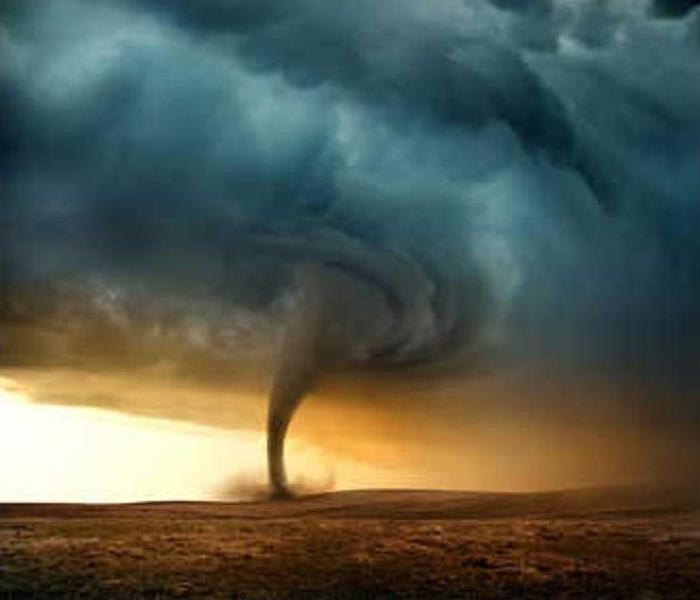 What to Do After a Storm Damages Your Indianapolis Home
What to Do After a Storm Damages Your Indianapolis Home
Even the smallest of storms can cause significant damage to your Indiana home. A limb can fall and damage your roof or windows. Wind or hail can damage the shingles of your roof. A tornado or high winds can uproot trees and tear off roofs. Even calm showers that last for days can ultimately cause flooding in your home.
While there is usually very little we can do to prepare or prevent such damage, there are steps we can take to reduce the damage from getting worse once the storm has passed. Below we cover simple steps that can be taken to reduce further damage to your home from happening. While some of the steps can be taken by the homeowner, it’s best to contact a storm damage cleanup and restoration company, like SERVPRO of Indianapolis West. The experts at SERVPRO of Indianapolis West have the experience and tools to handle any size disaster and restore your home quickly.
#1 Wait Until the Storm Has Passed Before Taking Action
If you should suffer severe damage to your home, wait until the storm has passed until surveying the damage. If you are listening to the storm coverage on the radio or TV, wait until the reporter has given the all clear for your area. Many times, there can be multiple severe storms or tornadoes that hit one area. It’s always best to be safe when dealing with severe weather.
#2 Take Photos or Videos of the Damage
Once the severe weather has passed and you are able to leave the safety of your home to survey the damage, be sure to take photos and/or video of the damage. This can be helpful when filing a claim with your insurance company and can also be helpful for storm damage cleanup and restoration professionals to know what equipment they may need on hand.
#3 Turn Off the Electricity if There is Flooding
If you have flooding in your basement or in your home, be sure to cut off the electricity before wading through or getting near the flooded areas. If you are unable to reach the fuse box to cut off the electricity then wait until the cleanup professionals or electric company can arrive to assess the situation. You never want to get near any standing water or flooded areas in your home for risk of getting electrocuted.
#4 Get the Water Out
If there is standing water in your home, you will want to extract it as soon as possible. The longer the water sits in your home, the more damage it can do. Flood waters, in particular, can quickly promote mold growth in your home if not removed and treated quickly. To ensure the water is completely extracted from your home, it’s best to have water damage professionals like those at SERVPRO of Indianapolis West handle the removal of water from your home.
#5 Air out the House
Once the water is removed from your home, you will still want to air out your home. The flood waters in your home most likely raised the humidity in your home. If you don’t air out your home, the humid air could carry mold spores and cause mold damage throughout your home. You can also use fans and dehumidifiers to remove the moisture from the air.
#6 Check for Exterior Damage
If you haven’t checked the exterior of your home for your damage, you will want to do that. Be sure to check for roof damage, standing waters near your home’s foundation, siding damage, and damage around windows. All of these areas can be causes of water to enter your home.
Contact the Storm Cleanup & Restoration Professionals
If you experience storm damage to your home, contact SERVPRO of Indianapolis West to get the damage cleaned up and your home restored. The professionals at SERVPRO of Indianapolis West have the expertise and know-how to handle whatever mother nature may throw your home’s way. Whether it’s flooding, water damage, mold growth or even fire, SERVPRO can handle it. Contact them today for complete cleanup and restoration.
SERVPRO Storm Restoration Services in Indianapolis
7/14/2017 (Permalink)
 Storms are relentlessly destructive to houses, property, and the contents within!
Storms are relentlessly destructive to houses, property, and the contents within!
Indianapolis has a reputation for its ”mild” climate, but those of us who live here know better! We Hoosiers know the pollen count is insanely high, and if it’s not hot, sticky, and muggy, then the Tornado Warning sirens are blaring. If we’re not seeking shelter from the twisters, we’re dodging hail rocks. And then there are the extra wet days, a few times every summer, when the hard, steady rain pours down like it will never stop.
Hail, tornado, and rain, mixed with our “Hoosier humidity,” means storms are relentlessly destructive to houses, property, and the contents within! Summer storms in Indianapolis can be devastating, and assessing the aftermath may leave you feeling helpless.
Fortunately, our experts at SERVPRO of Indianapolis West are focused on restoring and repairing your property and contents rather than just replacing them. We understand the importance of personal belongings and can restore damaged items some would write off as ruined. SERVPRO can work with you and your insurance company to return your home to its preloss condition, and make it “Like it never even happened.”
Water damage from storms / sump pump failure / roof and window leaks.
Our industry-leading water restoration techniques are second-to-none. Whether it’s a flooding emergency from a failed sump pump or a leaking roof or window, our crews can track the source of water and dry your home. We document the drying process using moisture detection equipment to ensure your property is completely dried. Sometimes water problems are in areas hidden from view, like in a crawlspace or attic. SERVPRO’s storm damage experts can find these water problems before they cause serious damage.
Mold mitigation.
Strong summertime storms here in Central Indiana usher in heavy rains that may enter your home. If left untreated you can experience secondary damage, such as mold. SERVPRO of Indianapolis West follows strict guidelines and industry protocol when mitigating mold. We isolate the affected area using physical barriers and a negative air pressure chamber for proper remediation. Mold must be taken very seriously; it poses health risks, especially to those with asthma and low immune systems. It’s important to address any flooding issues as quickly as possible, because mold can begin to grow within 48-72 hours.
Restoration of heirloom / memorabilia / sentimental pieces.
Using advanced drying techniques, we can restore your home and help save your precious possessions such as: important papers, photo collections, books, certificates, electronics, and other fragile / delicate valuables.
Property damage / power lines and who to call.
ALWAYS stay away from power lines. Call your local utility company or 911 if you see any downed power lines. If you receive heavy storm damage from high winds or a tornado, your home may not be safe. Always remember, SAFETY FIRST, and let the authorities clear your property of any potential hazards before going back inside.
So when storm damage strikes, don’t despair! Call SERVPRO of Indianapolis West at their emergency 24/7 phone # at 317-243-3149 where a live person is always there to take your call and schedule a FREE in-home consultation. We’re a preferred vendor with most Central Indiana insurance companies. And our 1-4-8 Emergency Service guarantees: 1) within one hour of contact, we're on the phone to arrange services. 4) within four hours, we're on site to begin mitigation services. 8) within eight hours, we'll have a prepared statement and a plan of action outlined for you and your insurance company. You can also email us directly at SERVPRO9518@ATT.NET .
Don’t leave your storm repair to just anyone. Trust the nationwide leader in storm cleanup at SERVPRO of Indianapolis West.
Need Flood Cleanup & Water Damage Restoration Services In Indianapolis Area?
7/11/2017 (Permalink)
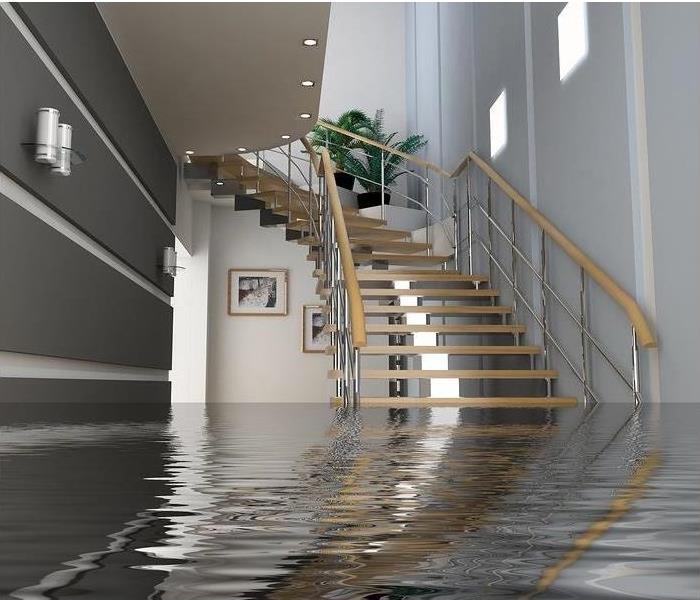 Need Flood Cleanup & Water Damage Restoration Services In Indianapolis Area?
Need Flood Cleanup & Water Damage Restoration Services In Indianapolis Area?
With the recent rash of heavy rains and violent storms throughout Indiana, many homes have suffered from flood and/or water damage. Not only are the rivers, like the White River flowing through central Indiana, rising and breaching their banks but the extensive rain has saturated the grounds. As a result, homes where flooding is usually not a problem, are experiencing flooded basements and water damage.
Fortunately, the experts at SERVPRO of Indianapolis West can help dry out, clean and restore your water damaged home or business. SERVPRO has the equipment and the experience to restore water damage of all sizes. Whether you have water seeping in from your basement walls or river water rising and flowing through your home, SERVPRO of Indianapolis West can help remove the water, dry out the damaged areas, and restore the damage as if nothing ever happened.
What You Should Do If You Experience Flooding in Your Home or Business
If the nearby river or stream is rising and threatening to flood your home or business, call SERVPRO of Indianapolis West immediately. They will be able to assist in reducing the damage caused by the flood waters. If you wait until the flood waters have had time to flow through and saturate the interior of your home, you could be facing, even more, damage from mold. Mold can grow within 24 hours after gray water or black water from flooding has entered your home or business. By reacting quickly and calling SERVPRO of Indianapolis West immediately, the mold can be prevented or at the very least minimized before it has caused too much damage.
Flood Damage Cleanup and Restoration in Indianapolis, Indiana
If you should experience flood damage or storm damage to your Indianapolis-area home or business, call the water damage cleanup and restoration professionals at SERVPRO of Indianapolis West at 317.243.3149. The professionals at SERVPRO of Indianapolis West have the specialized equipment, professional training, and certifications to quickly cleanup, repair, and remediate damage from fire, water, mold, and storms to home and businesses around central Indiana.
Top Ways Severe Storms Damage Indiana Homes & Businesses
6/25/2017 (Permalink)
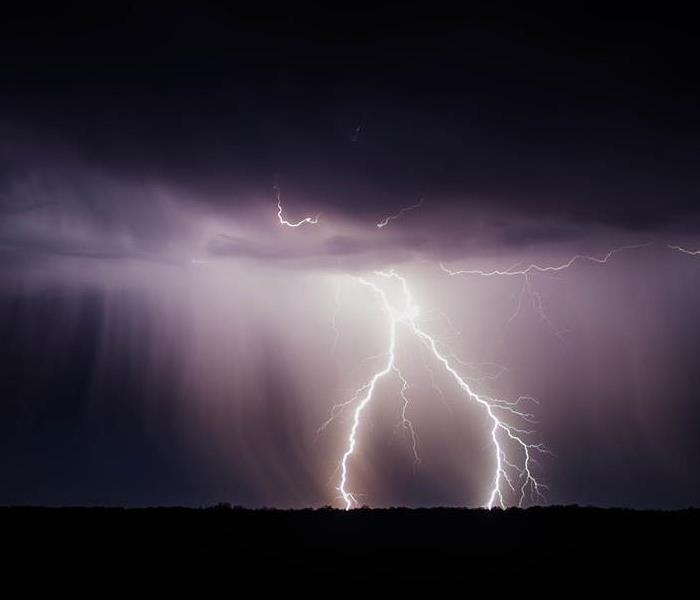 Severe Storms Can Easily Damage Indiana Homes and Businesses in Many Ways
Severe Storms Can Easily Damage Indiana Homes and Businesses in Many Ways
Severe storms are as common as corn in Indiana, especially during the spring and summer time. While they are usually short lived and tend to blow through rather quickly, storms can leave a path of destruction for businesses and homes in Indiana. The worst part about severe storms is they have many ways to cause storm damage in Indiana with very little ways to prevent it.
Damage from Heavy Winds
The summer time seems to be the most popular for storms with heavy winds. They usually run in a vertical line and rip across the state from the west to the east. While they blow through quickly, their winds can reach up to 70+ mph. These damaging winds can tear shingles off roofs, rip trees out of the ground, pull siding off of homes, and blow large debris through windows. Once they tear or blast a hole into a home or business, the rains can come inside and cause further damage.
Damage from Large Hail
Golf ball-sized, baseball-size, softball-sized...there are many ways to describe the size of the hale and unfortunately, they are all quite destructive. Hailstorms tend to cause the most damage to cars and roofs. It’s not surprising to see dozens of roofing companies out installing new shingles after a large hailstorm. Hail usually doesn’t cause further damage besides dents in cars and damaged shingles but the larger hailstorms can break glass windows and doors and tear up roofs enough to cause water to leak inside.
Damage from Lightning Strikes
Lightning strikes can be very scary and deadly. While you should be safe if you are inside when there is a lightning storm, the lightning can damage your home in a couple different ways. The main damage lightning causes homes and businesses are starting fires. Lightning can cause an electrical fire by striking and running through all of your home's wires. It can also ignite wood whether it be a tree beside your home or the home itself. Lightning can also hit large trees and cause them to fall. Trees falling on homes and tearing holes through roofs and sometimes destroying an entire side of a home are where lightning can cause the most damage.
Damage from Heavy Rains
As the storms roll through your area, they can release a lot of water in a quick amount of time. This quick accumulation of rain can cause flash flooding and overwhelm sump pumps. Flooded basements or water seeping through the basement walls is a common occurrence that we have all either experienced or known someone that has experienced this terrible event. With storms causing water damage inside homes and businesses, it’s important to act quickly to get the water removed and the affected areas dried out. It only takes a day before storm water can cause even more damage by promoting mold to grow in the damp areas. Mold can grow in the carpets, drywall, wood framing, furniture, and insulation. It can turn a bad situation into a much worse situation requiring mold remediation.
Damage from Tornadoes
When it comes to storm damage in Indiana, tornadoes can be the most destructive. A direct hit from a tornado can tear off roofs, blow out windows, hurl large debris through exterior walls, and at their worse, they can completely level a home or business. With an indirect hit, businesses and home can experience broken windows and damage to roofs. All of this damage from a tornado can lead to more damage from rains entering the home or building which can then lead to mold growth.
Storm Damage Cleanup and Restoration in Indianapolis, Indiana
If you should experience storm damage to your Indianapolis-area home or business, contact the storm damage cleanup and restoration professionals at SERVPRO of Indianapolis West at 317.243.3149. The professionals at SERVPRO of Indianapolis West have the specialized equipment, professional training, and certifications to quickly cleanup, repair, and remediate damage from fire, water, mold, and storms to home and businesses around central Indiana.
Heavy rains in Indianapolis brings many flooded basements.
5/4/2017 (Permalink)
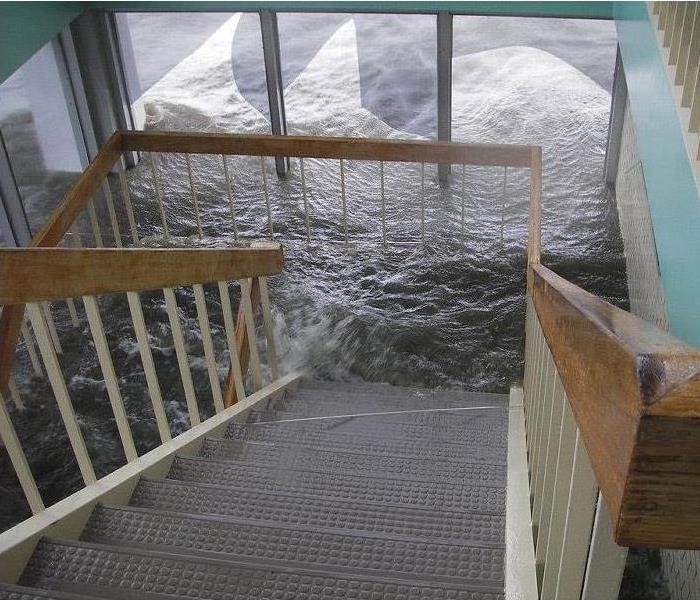 Way too much water in my house.
Way too much water in my house.
With all this rain recently in Indianapolis, sump pumps are being overworked and overwhelmed. Some pumps seem to be working properly, but still allows water to backup in the basement or crawlspace.
If you have standing water (flooding) in your basement, disconnect the main electrical switch or call your local fire department to do it for you! If you are in doubt about the electrical safety of your basement, it's best to stay out of it! Remember safety first!
Call SERVPRO of Indianapolis West and our certified Water Restoration Technicians will make it "Like it never even happened."
The water removal and water cleanup process is completed by our highly-trained technicians who will document the drying process. This validates that your property has been dried properly and thoroughly.
We're routinely called to homes and business all across Indianapolis to cleanup after a flood has happened. We feel like we've seen just about everything and can handle any Fire-Water Restoration job that comes our way. That's why when Indianapolis experiences heavy rains like we're currently having, we have the training to return your home to it's preloss condition.
When water damage strikes, a fast response is critical. Day or night, Indianapolis residents and business owners can expect us to respond immediately to your water emergency. Call us, SERVPRO of Indianapolis West 24/7 for emergency services 317-243-3149.





 24/7 Emergency Service
24/7 Emergency Service



























